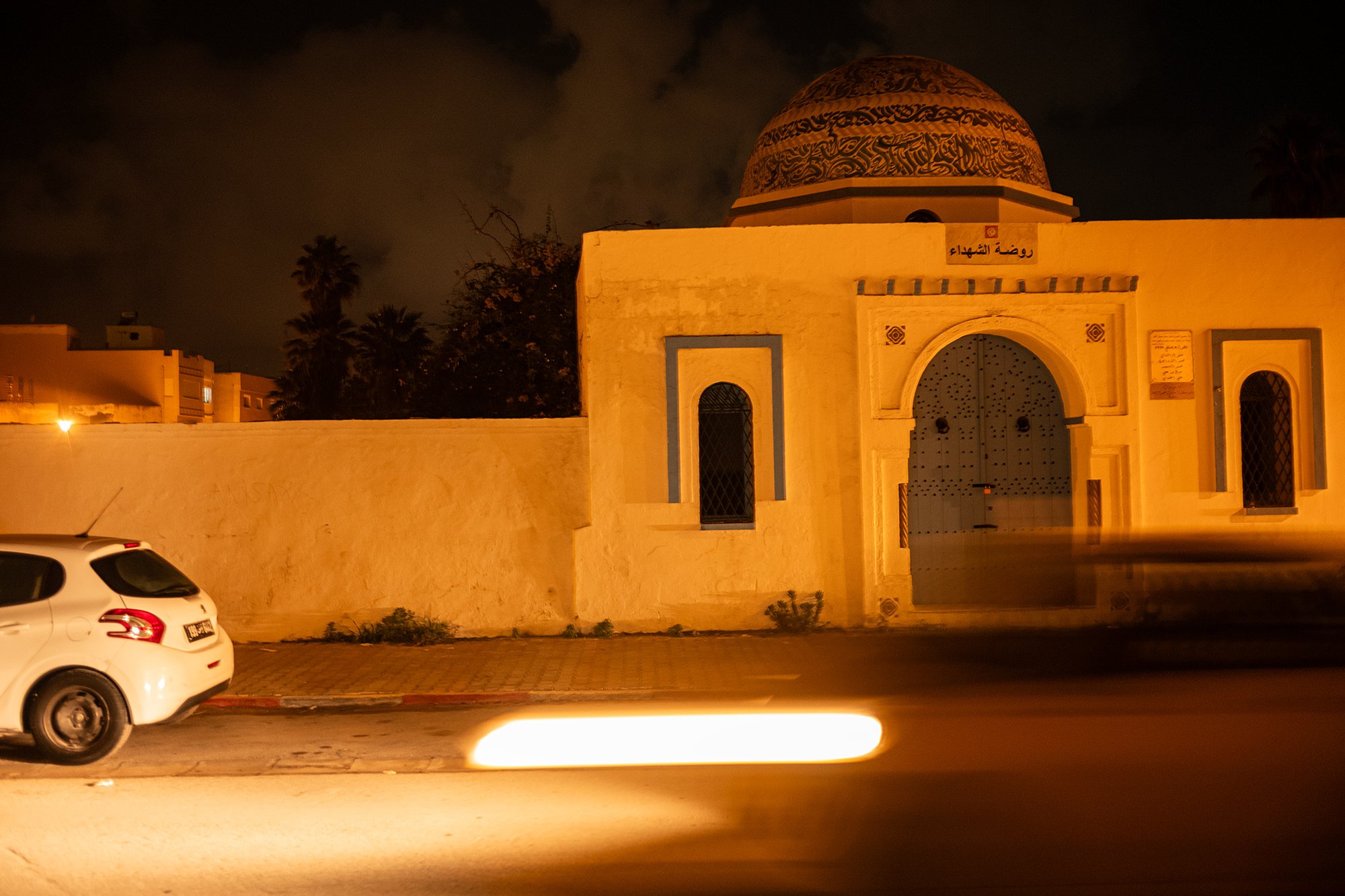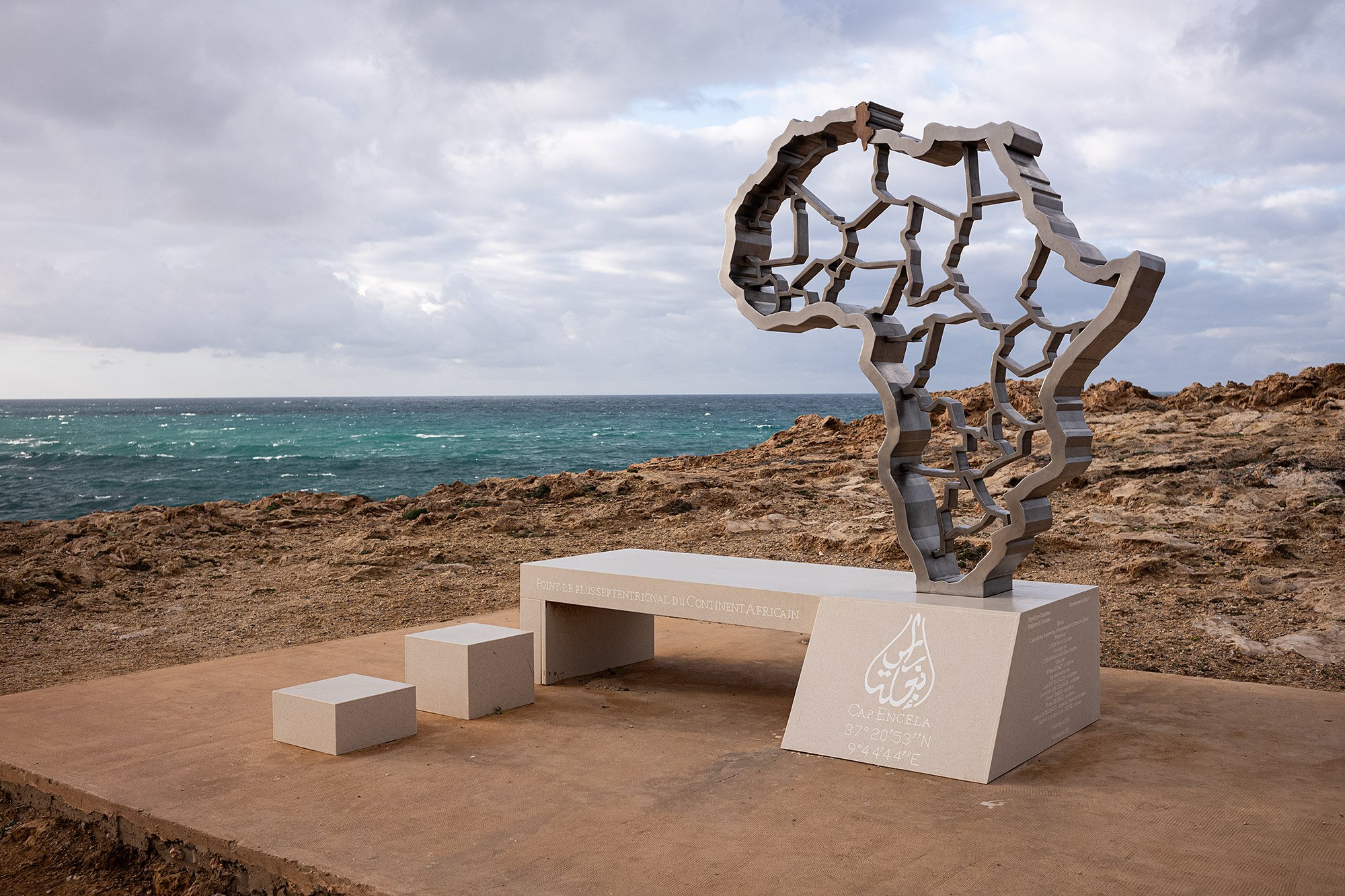
Tunisia chapter twelve
Bizerte and Cape Angela, the northern-most point in mainland Africa.
In Senegal, I was lucky to have visisted the westernmost point of continental Africa. In Tunisia I set off to see the northernmost.
I leave the apartment at 0930 and walk north to the edge of the medina, emerging into a large plaza anchored by the Tomb of Sidi Mehrez, Mausolée Sidi Mahrez.
From there I follow a main road past the Bab Saadoun bus station to where the louages collect, looking for a van to take me to Bizerte.
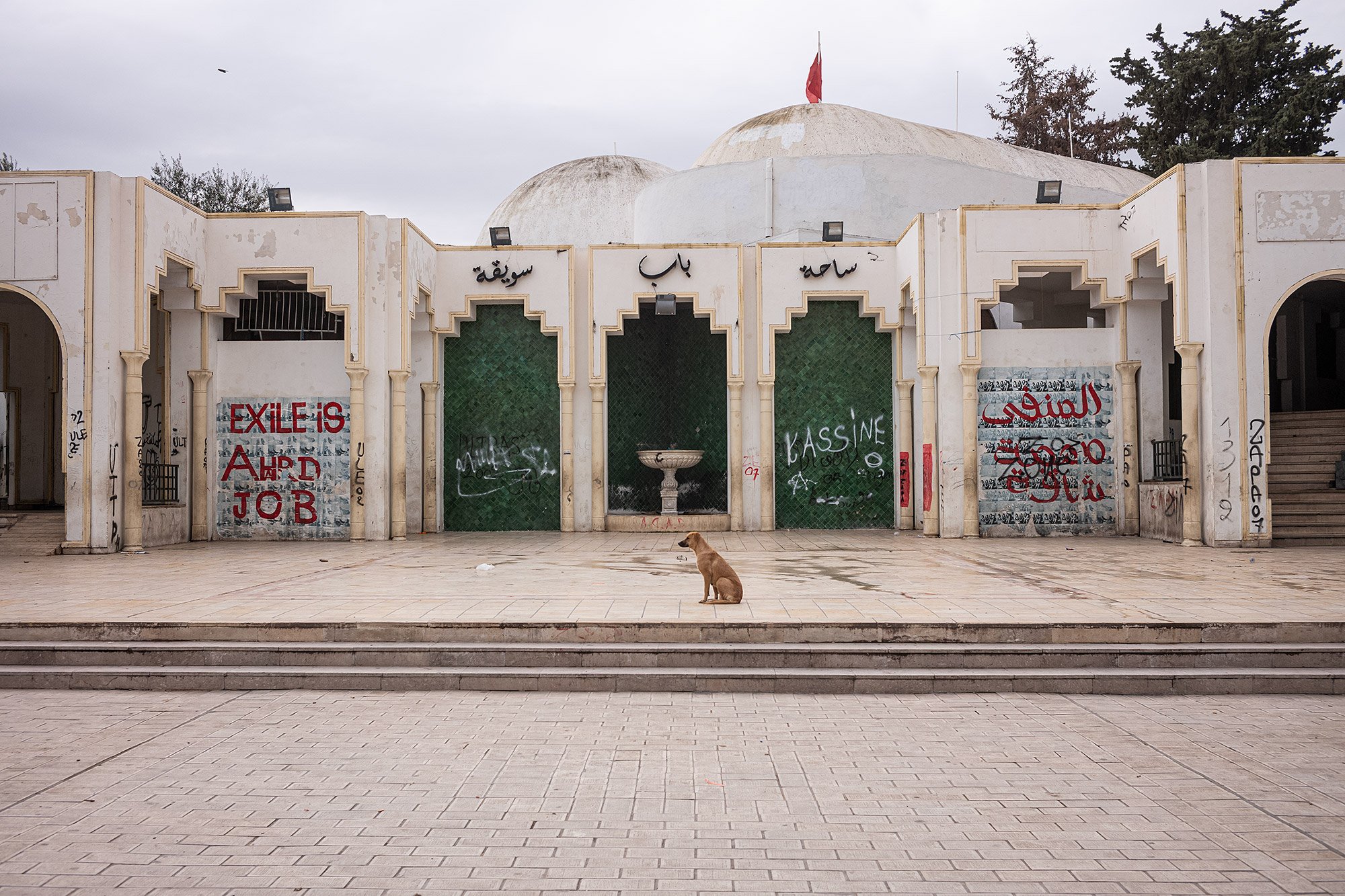
The lot is full of identical white vans, with a red stripe running the length of their sides. I ask where I can find the louage to Bizerte and am told it’s towards the end of the lot and to keep walking. Two attendants ask me to take their photo and I’m happy to oblige. They give me a WhatsApp number to send it to.
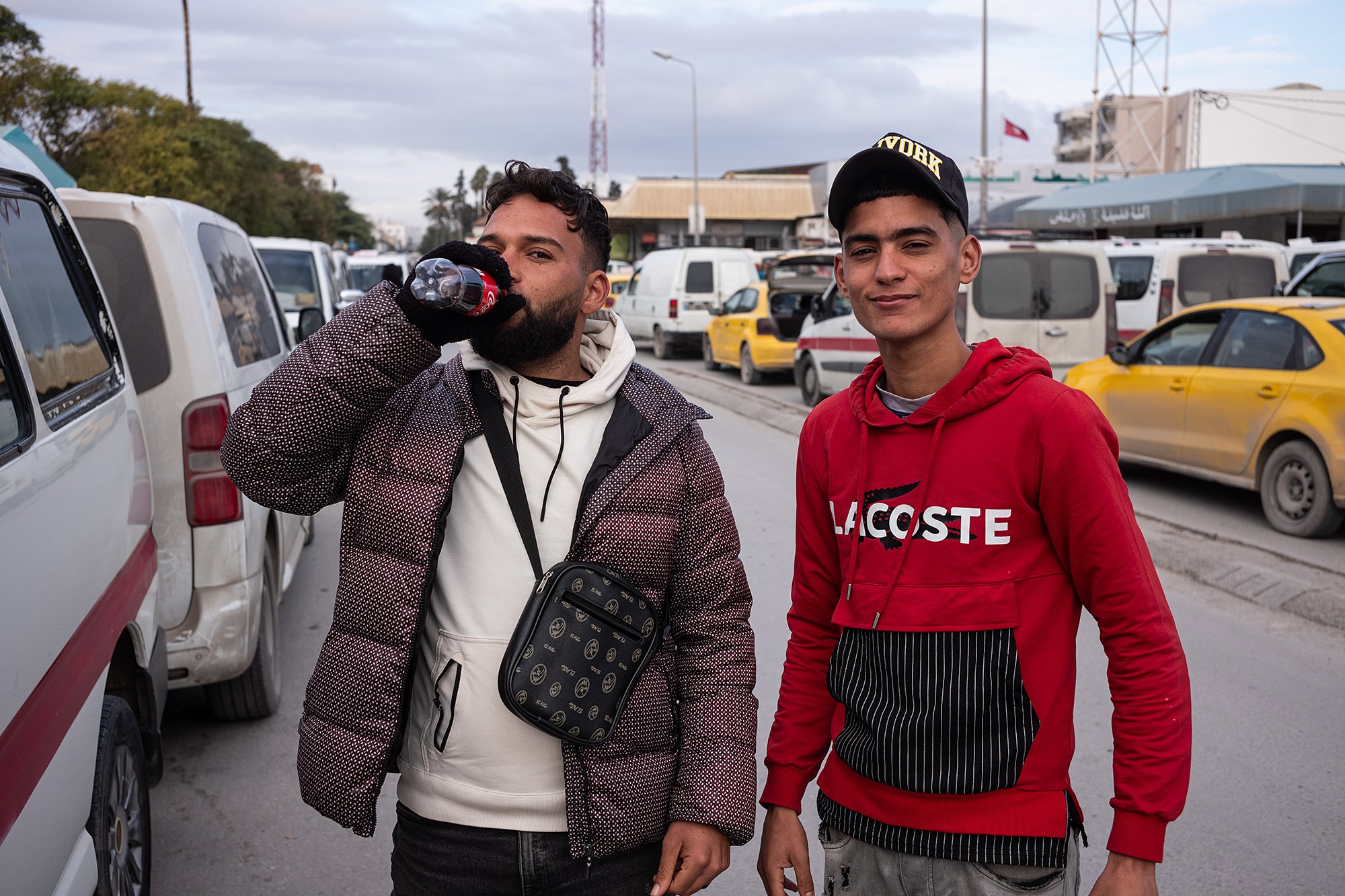
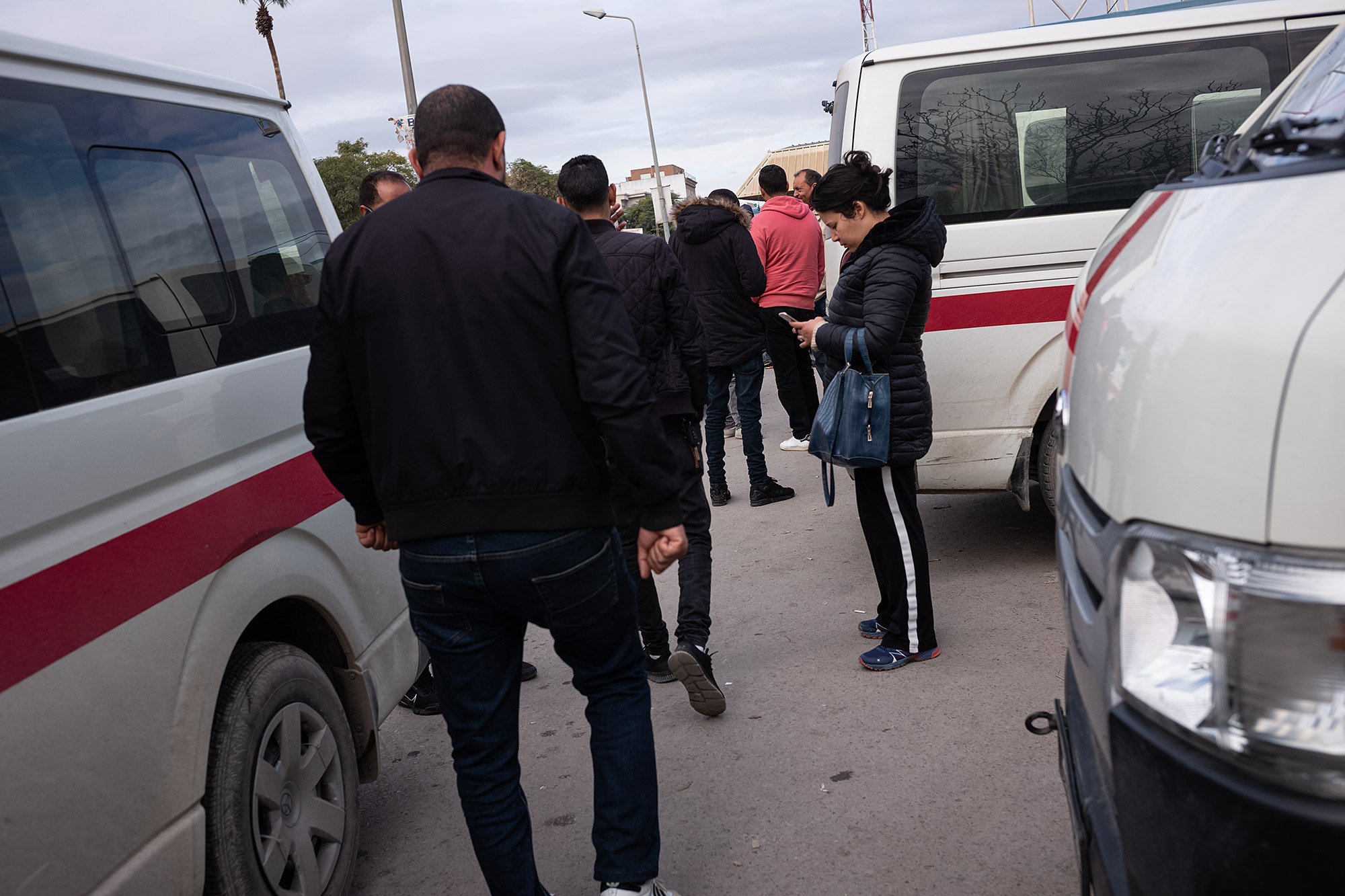

A louage is leaving just as I find the area of vans bound for Bizerte. I climb into the back and settle in for the ride. Along the way I see passengers pass bills and coins from one to another up to the front. The driver collects the money and sends change back the same way. I fish a bill from my pocket and pass it forward, my change arriving sometime later.
The louage stops just outside of Bizerte in Zarzouna. It’s about a 30 minute walk to my guesthouse and I debate taking a taxi, opting in the end to walk.
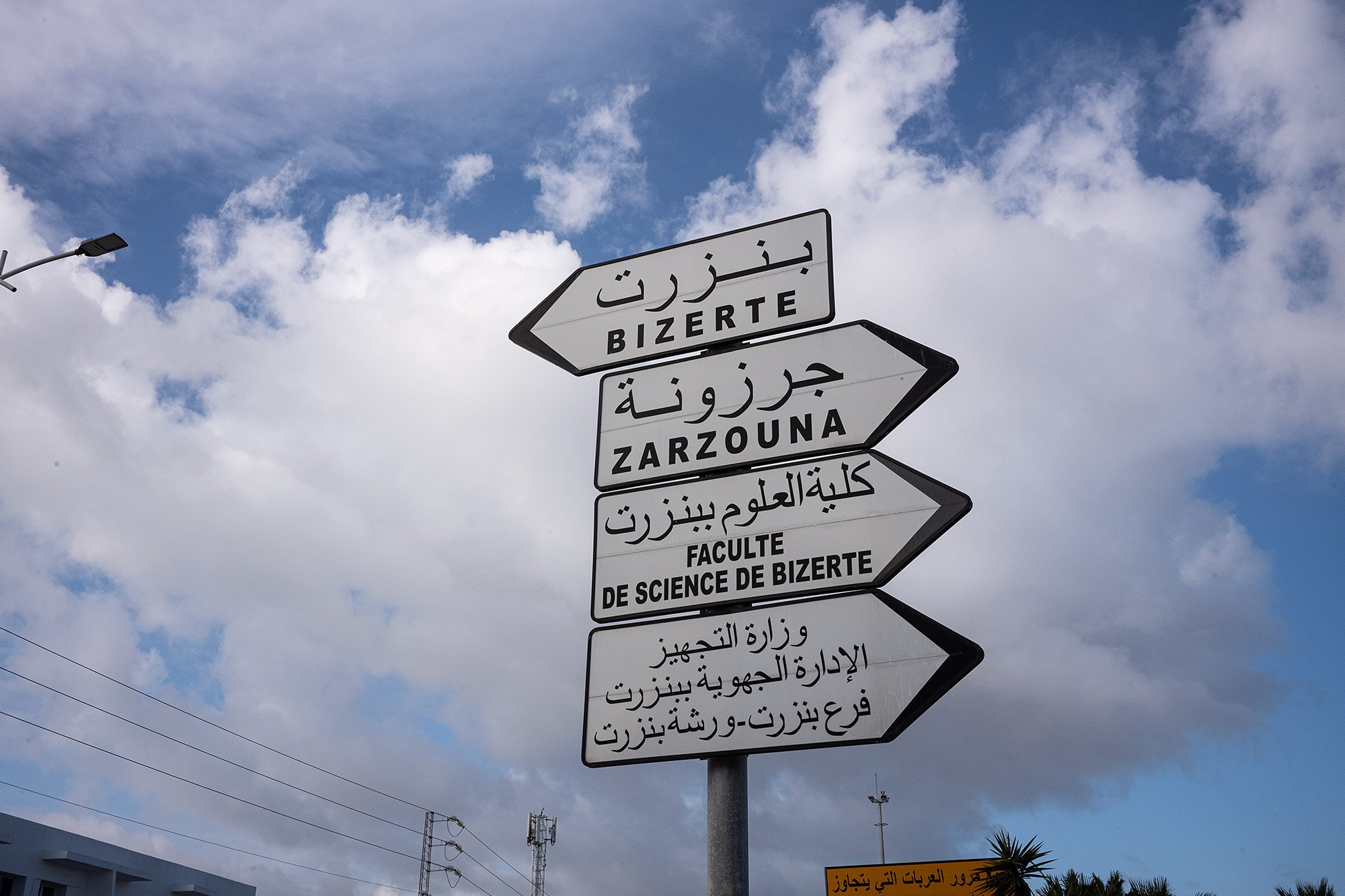
I follow the main road north through Zarzouna to the Bizerte Bridge that crosses the Canal de Bizerte. The bridge is congested, cars bumper to bumper as they slowly siphon from one town to the other. I can see why louages to Bizerte stop in Zarzouna.
It’s a beautiful day. I linger on the bridge to compare the towns that line the canal. One has built a park alongside the water; the other a parking lot.
The sun is strong and I find myself shedding my jacket as I cross into Bizerte.
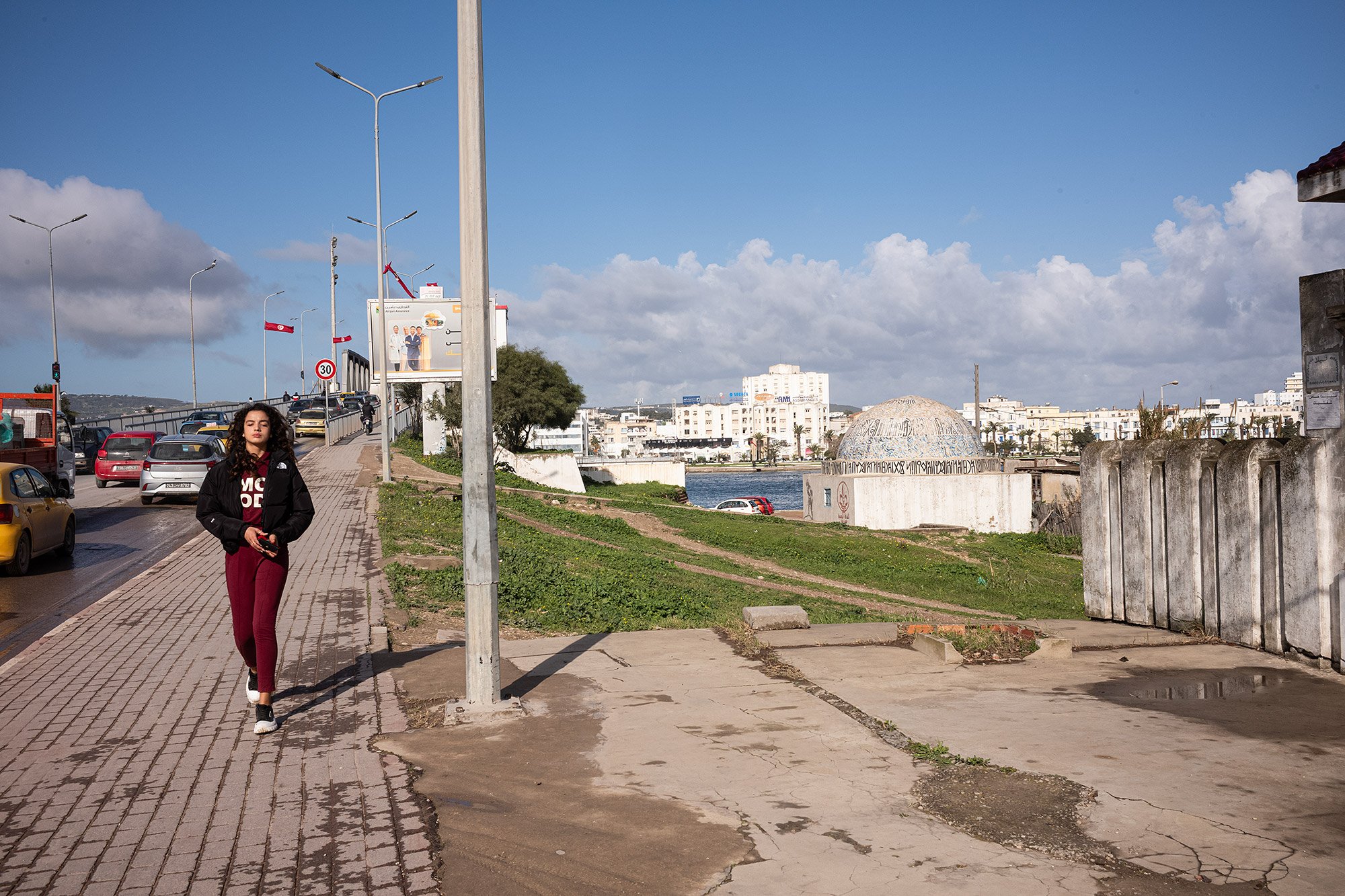
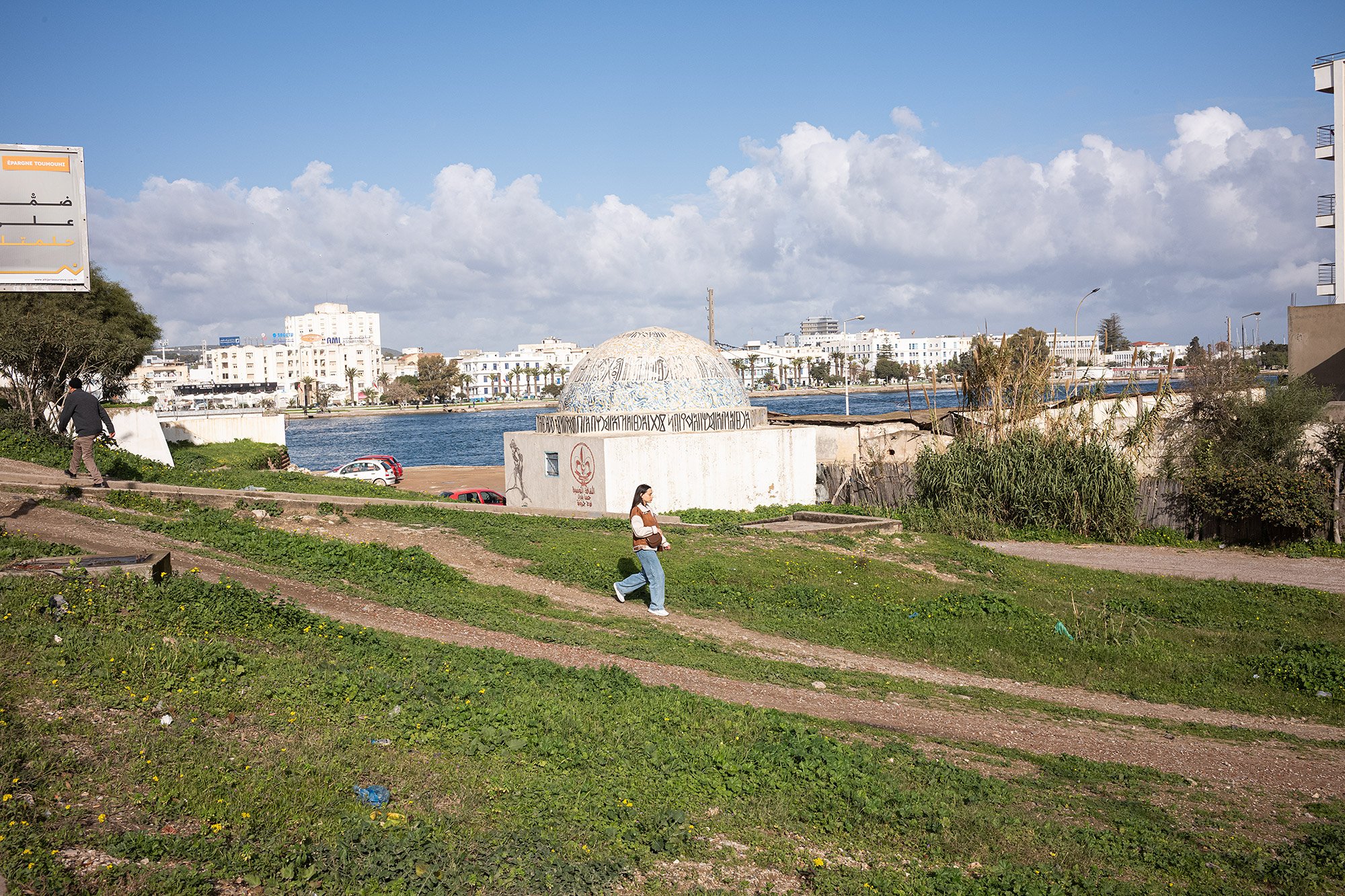


I’ve not eaten yet and near the Place Foch I pass a cart selling sandwiches. My stomach grumbles and I consider stopping, but I’m eager to drop my bags and see about arranging transport to Cape Angela.
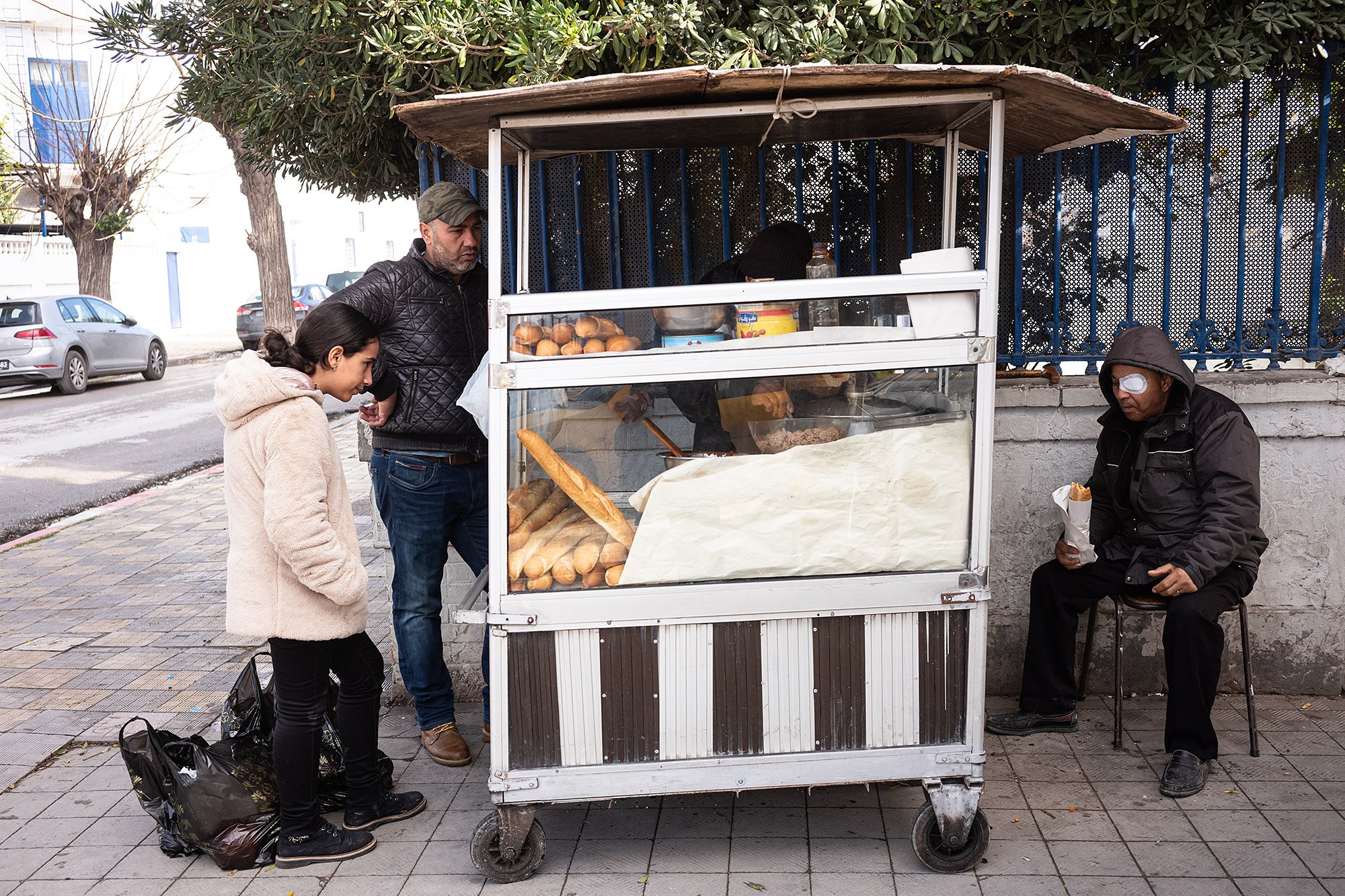
On the main street I pass a sandwich shop and can’t contain my hunger. I buy a tuna sandwich and eat it from the bag while standing on a corner.
In the center, the street turns into a market and I join the crowds as they make their way to and from the port.
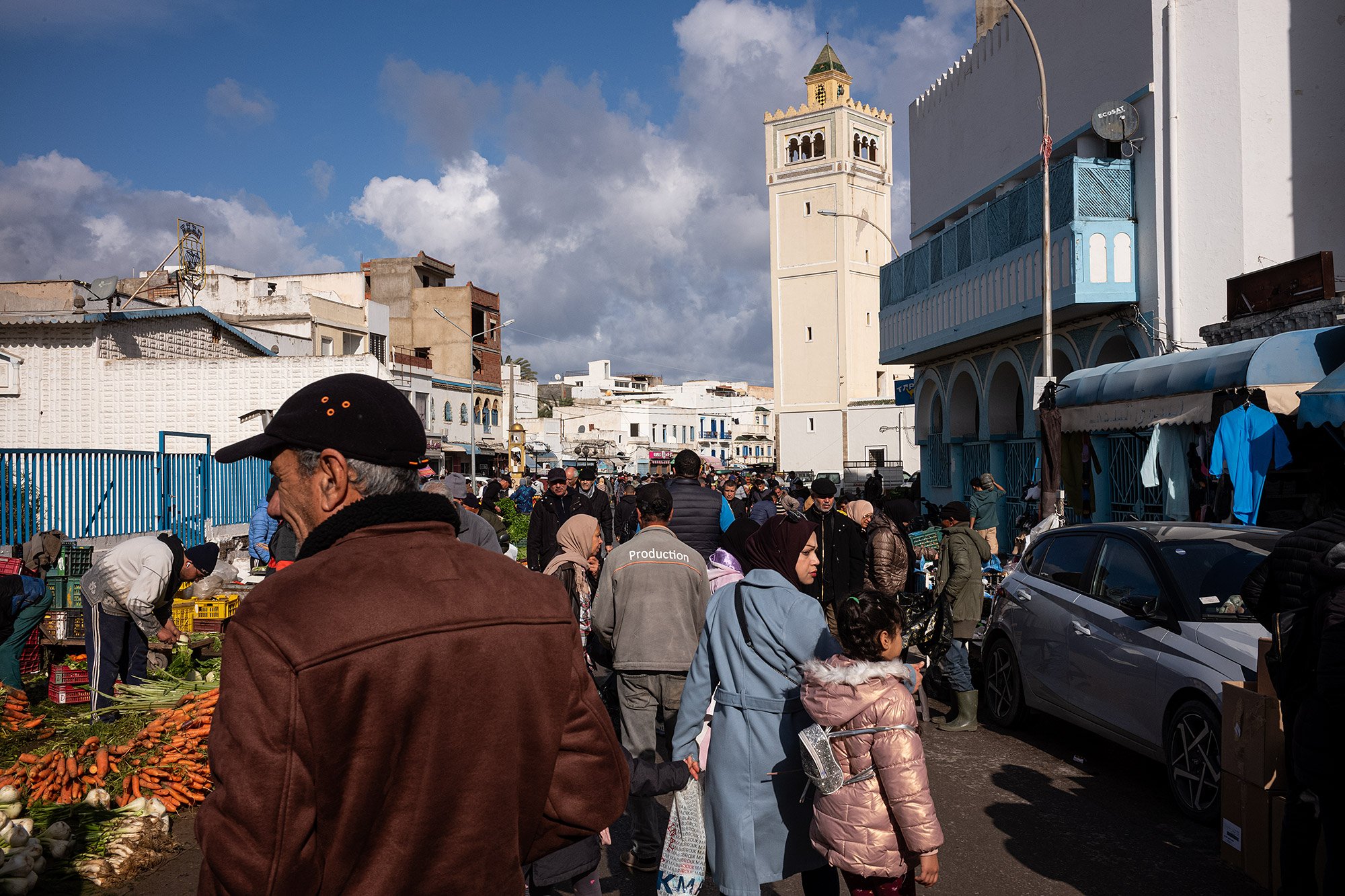

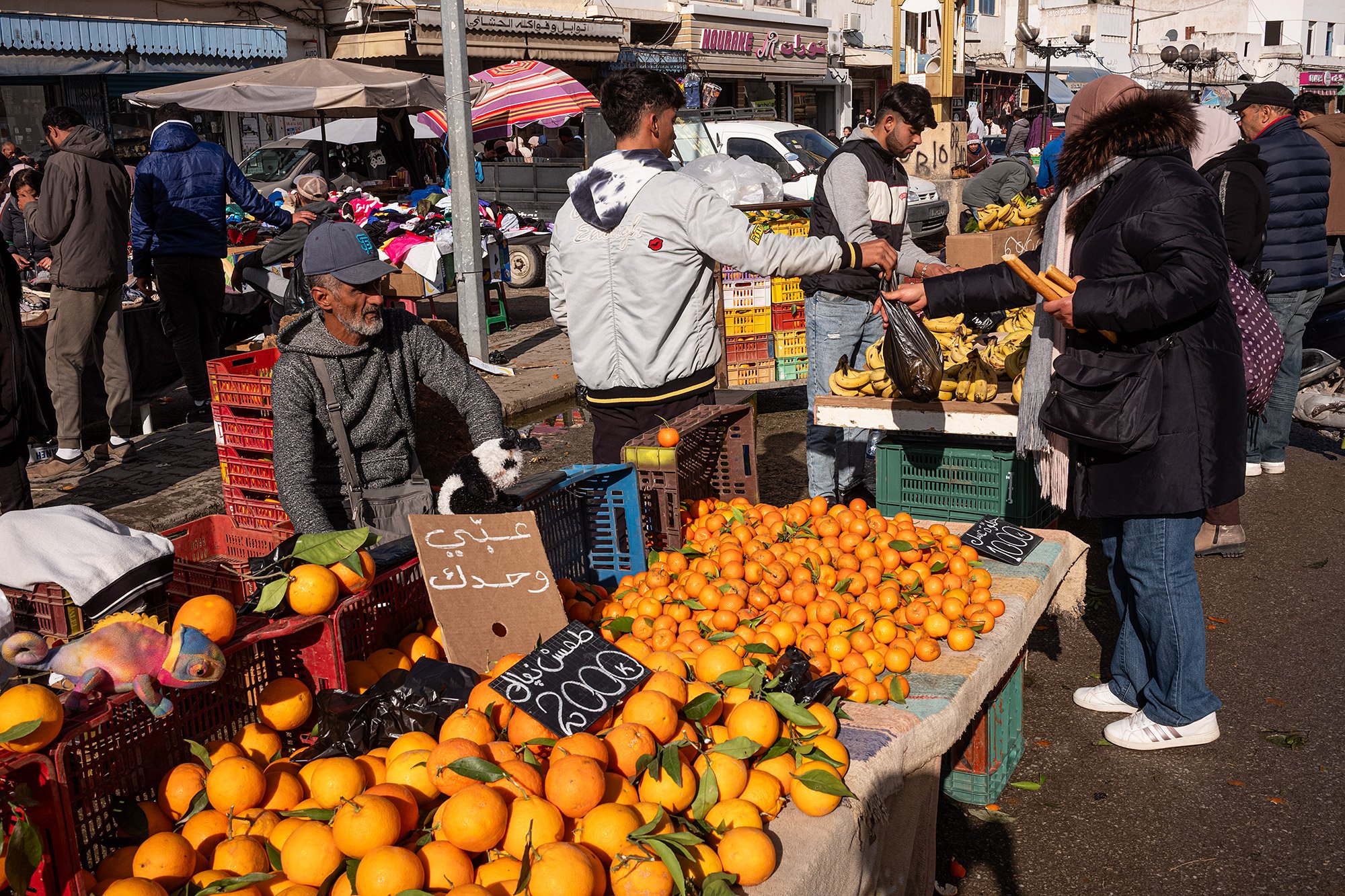
Looking past the stalls and the stores that line the street I spot openings that lead to a street behind the storefronts. I’m curious and head down an alley and follow the cobblestoned streets parallel to the road I had been on.

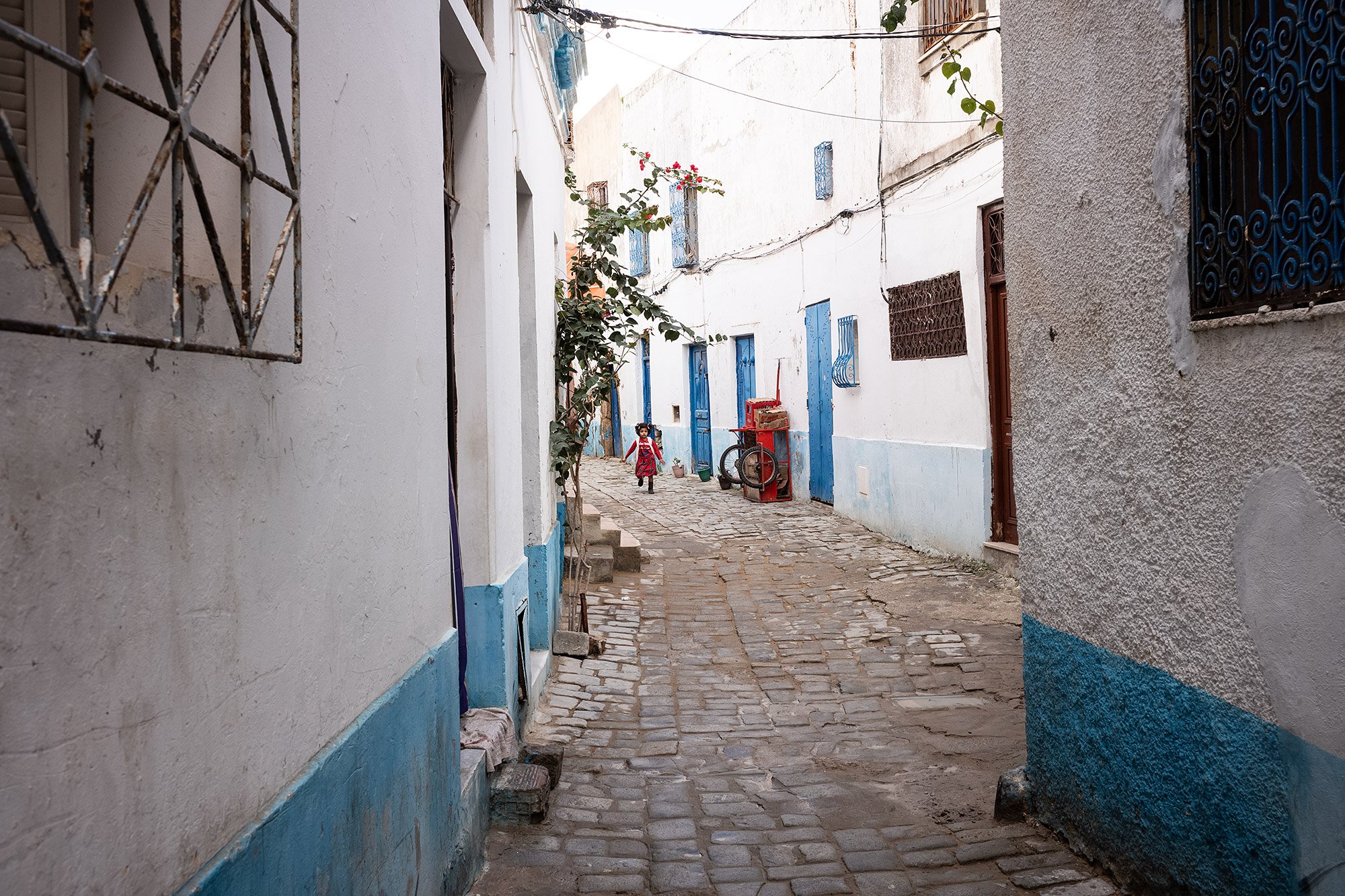
The street opens out to the port and I’m excited to have my first glimpse of the castle walls and the restaurants and cafes that line the atmospheric Vieux Port. I made note of a few, determined to have dinner looking out over the water and boats tied up to the piers.
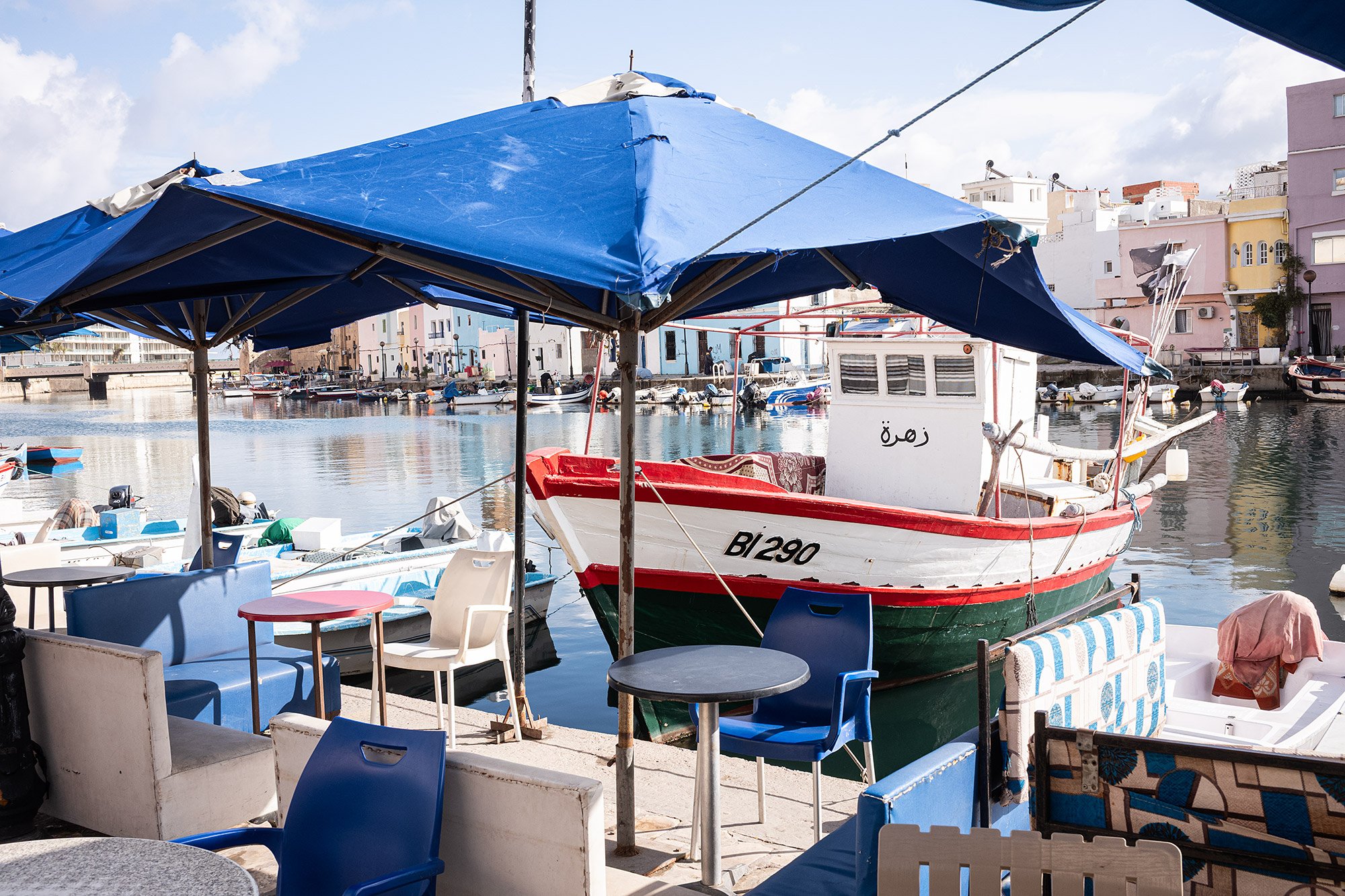
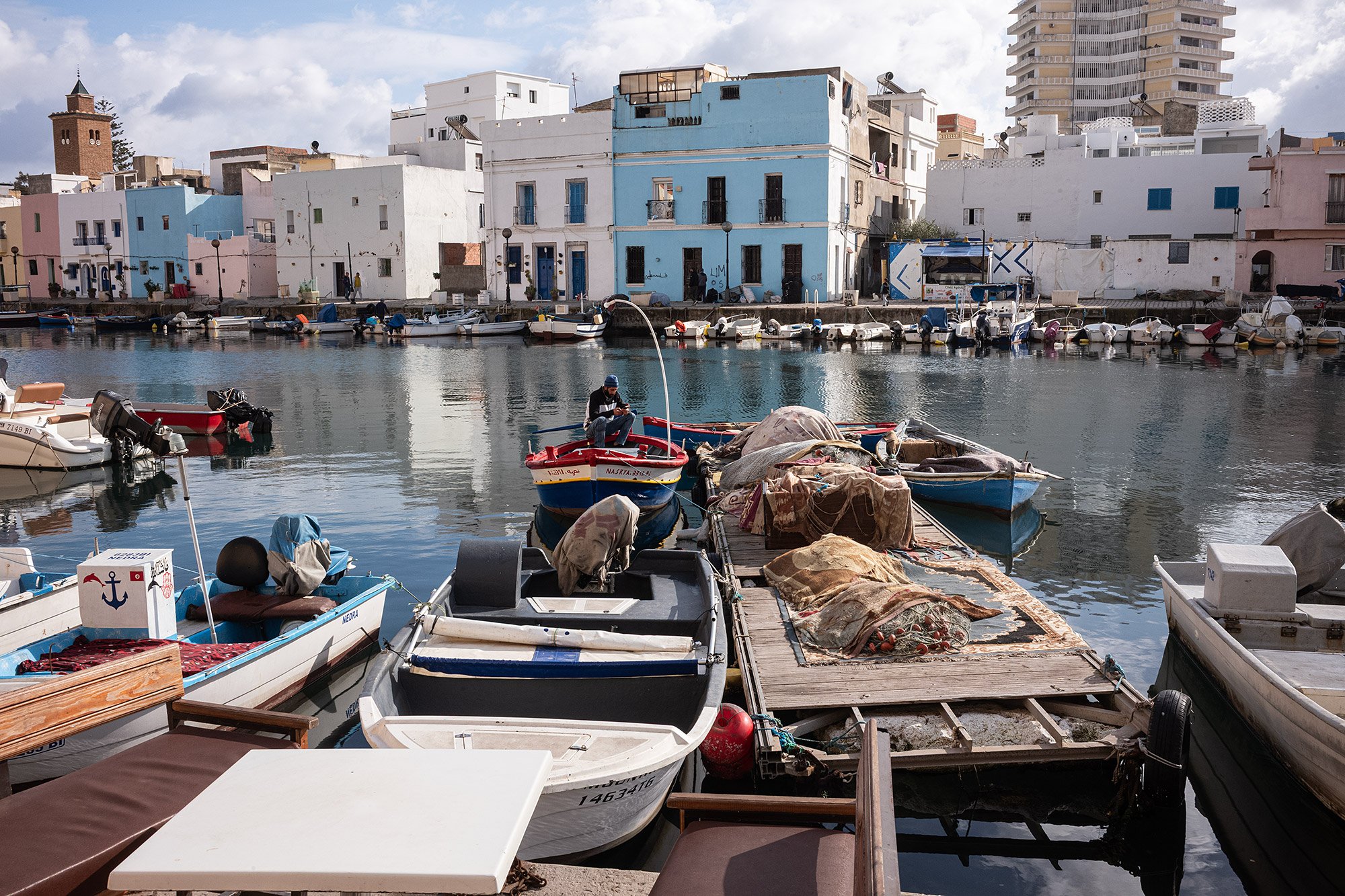
I’m following Google maps, but can’t find the entrance to the kasbah. The map suggests there’s an entrance along the castle walls running along the water but I walk to the end and around the corner without success, though I enjoy the exploration and the views of the castle walls it afford.


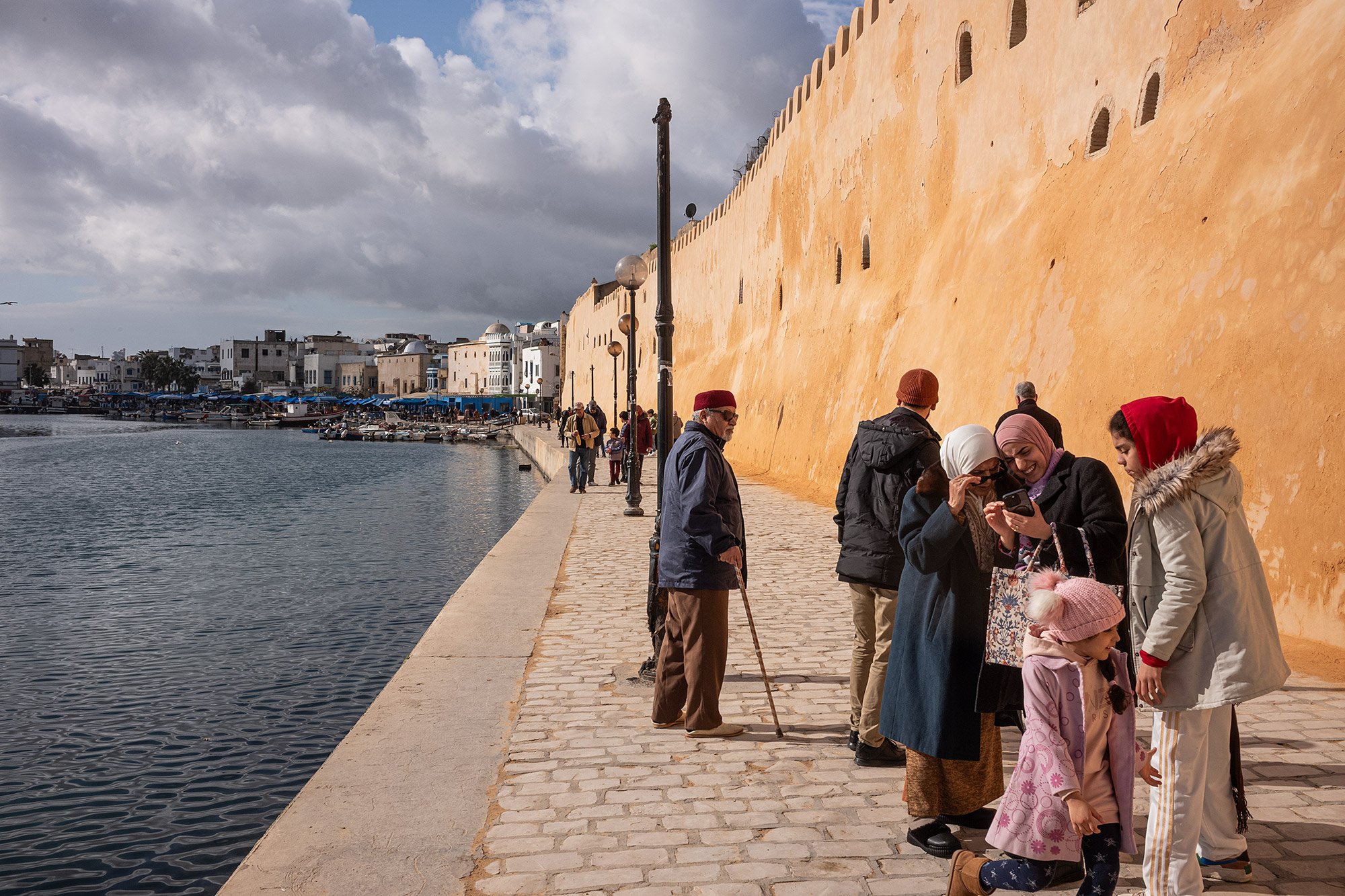

I retrace my steps and follow the castle walls again, this time with the castle to my right. I walk through a plaza lined with cafes to find the Khoukha Gate, the castle’s lone entrance. All roads lead to and from this spot.
The medina is small and picatresque, blue doors and windowshades carve blocks of color from the white walls of the dwellings inside.

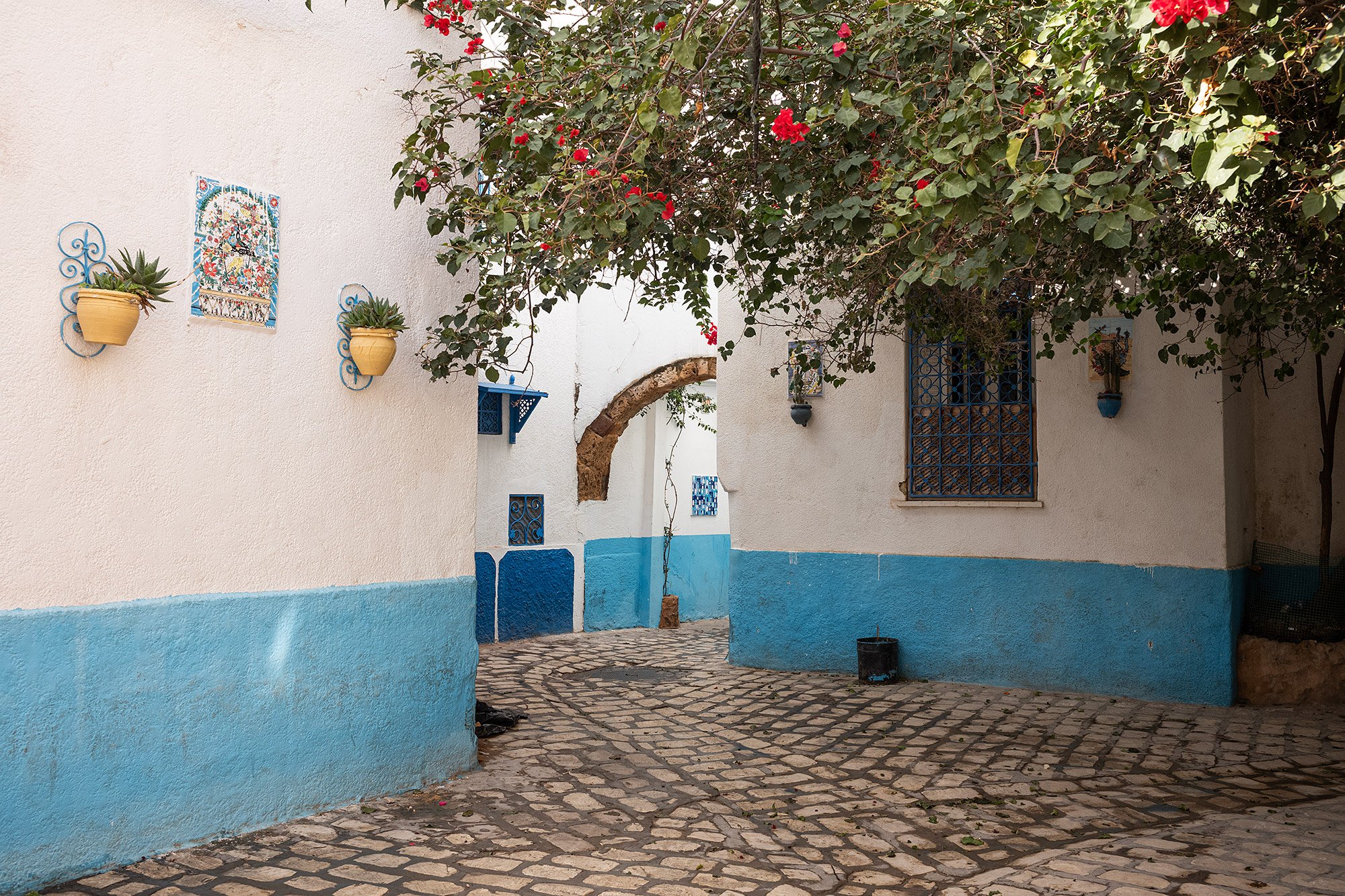
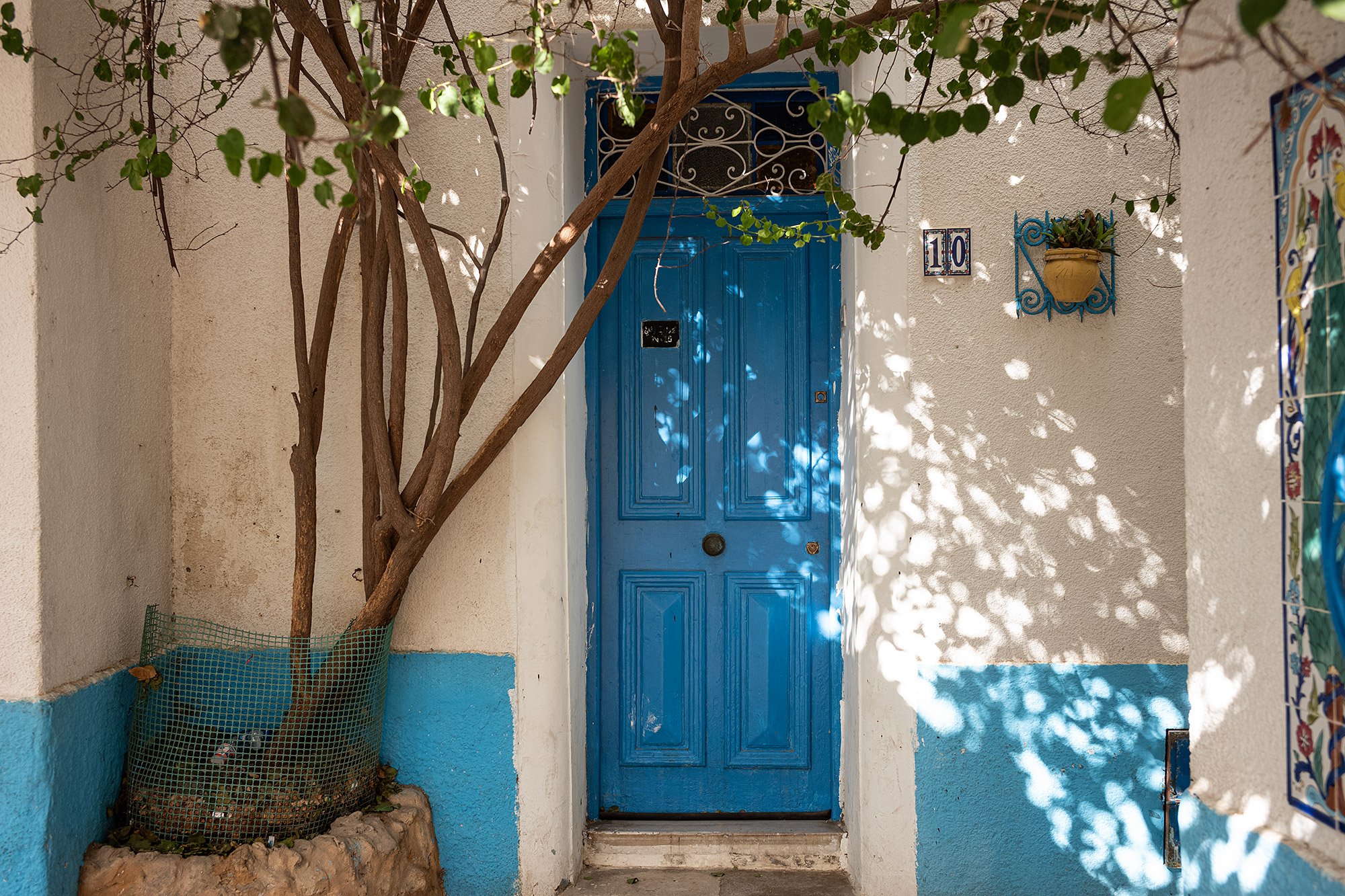


It’s not hard to find the guesthouse; there are few roads, and even if I wander down the wrong alley it eventually winds back to main road that runs to the gate.
Raina meets me to check me in. It’s a family home and the children watch tv in the living room. The room isn’t quite ready and I’m invited to relax in the common area. I ask about ways in which to reach Cape Angela and am told they have a friend who can drive me. Raina makes a call and tells me he’ll be by in about an hour.
I head to the rooftop terrace of the guesthouse to relax, where I meet Raina’s husband Sofiene. We chat about his family and his life in Bizerte for a bit before he leaves to attend to some chores.
When my room is ready I’m called down to the second floor. The rooms line the walls of the building with doors that open up to the interior, an open atrium that runs from the ground floor up to the roof.
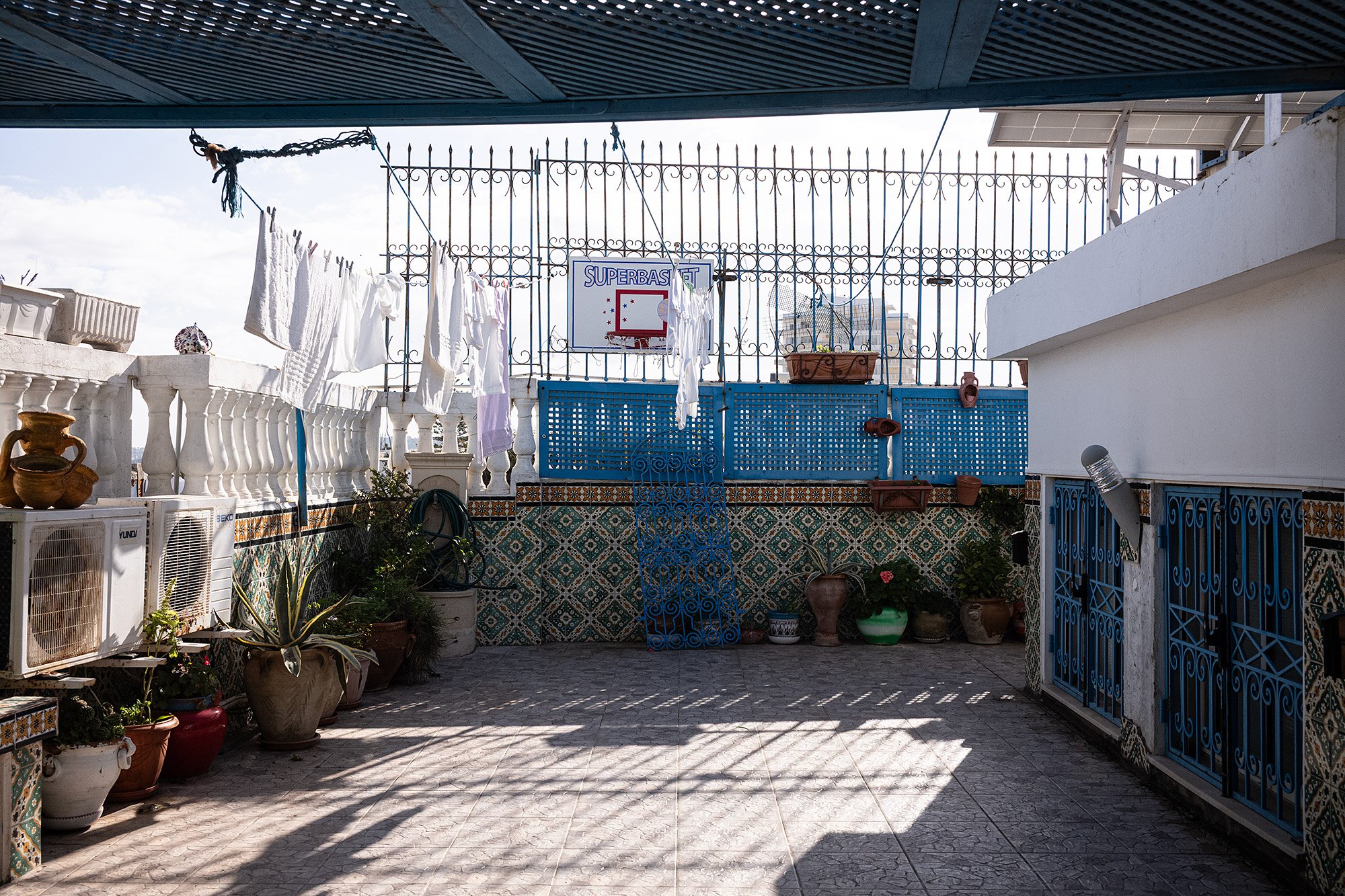
Sofiene leads to out of the medina to find his friend Norman parked just outside the castle walls. I climb into the car and we head out of town.
As we drive north the surroundings become more and more rural; green fields cover the landscape stretching out to the distant mountains. The sky clears and then becomes overcast, and a slight drizzle sprinkles the windows.
We had been driving along the highway and then Norman turns the car to retrace our path. I’m not sure if we’ve missed a turn. Norman tells me he had hoped to take me the long way around on the scenic route that circles back along the coast, but with the coming rain he’s concerned that we’d get stuck. It’s an unsealed road and gets muddy when wet.
He tells me he was a diver for 24 years, mainly for red coral in Tunisia, Morocco and Algeria. He tells me his deepest dive was at a depth of 120 meters, but that he retired four years ago. I tell him that diving is one skill I’d like to learn. He tells me to come back next summer; he’ll teach me.

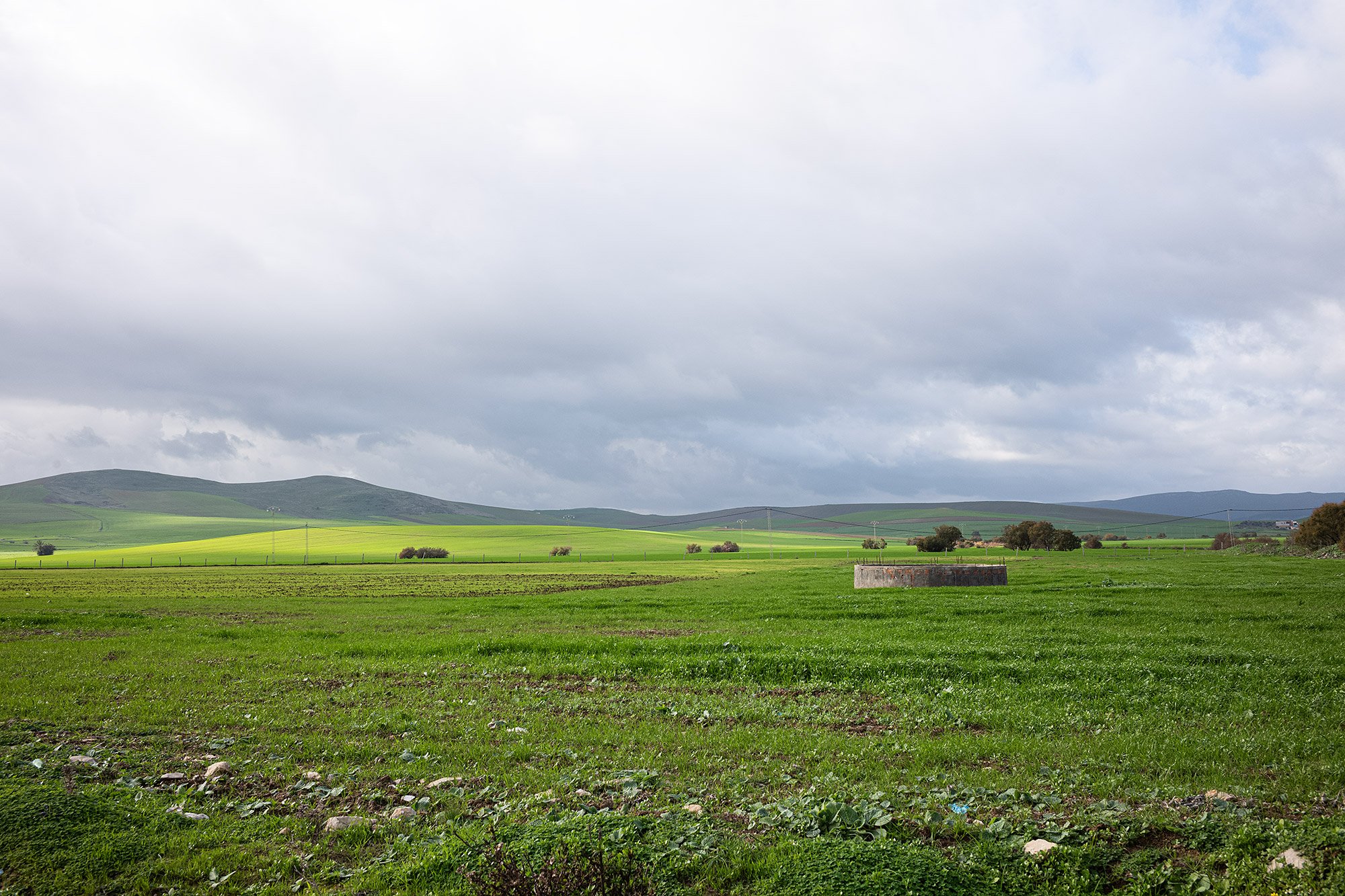
We turn down another road and wind around the hills towards the coast. The car strikes a rock or a pothole and a grinding noise starts to emerge from underneath the car. Norman pulls to the side of the road. A plastic panel has come undone from under the car and he struggles to work it free. He puts it in the trunk and tells me he’ll have it fixed later.

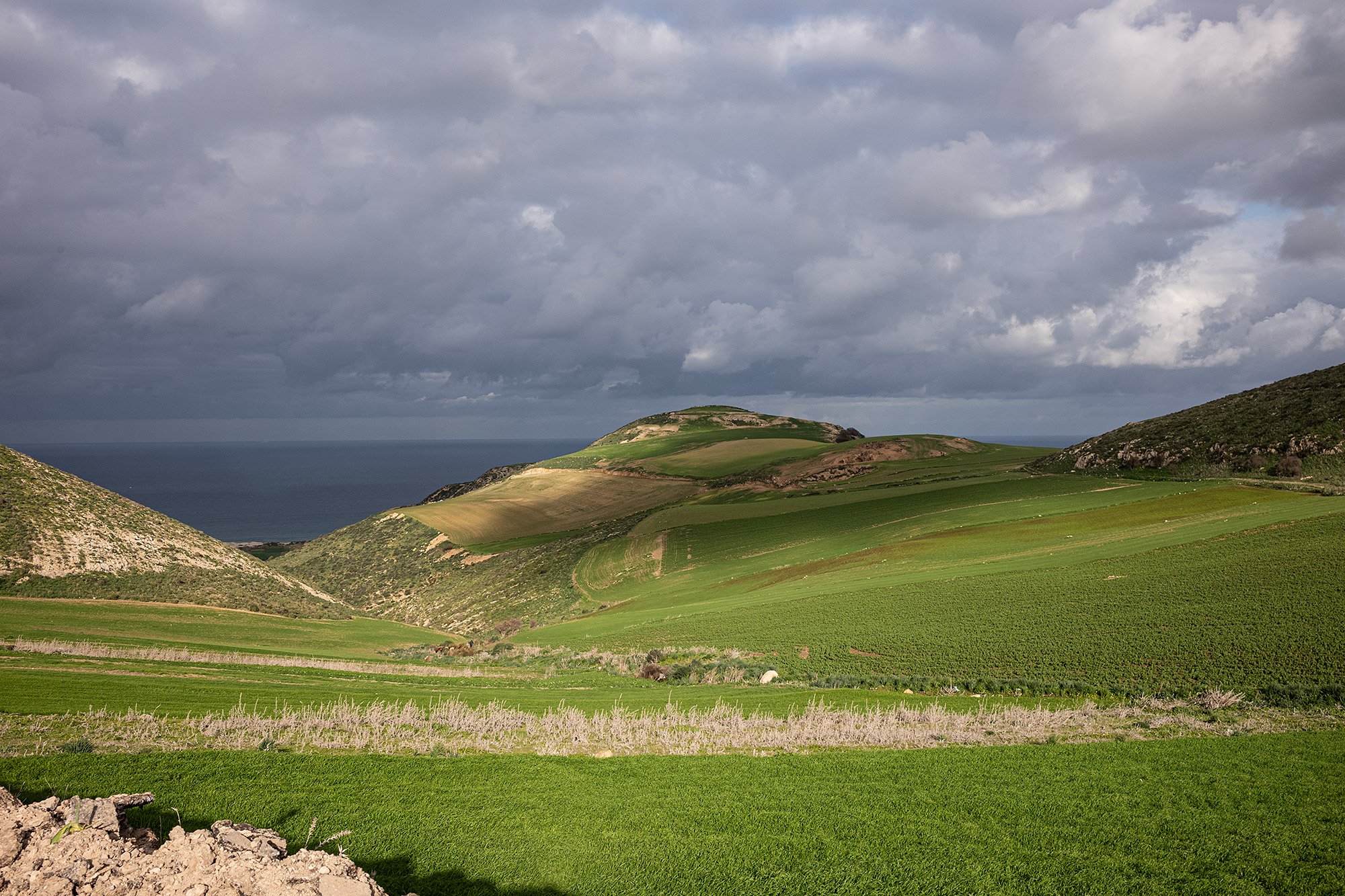
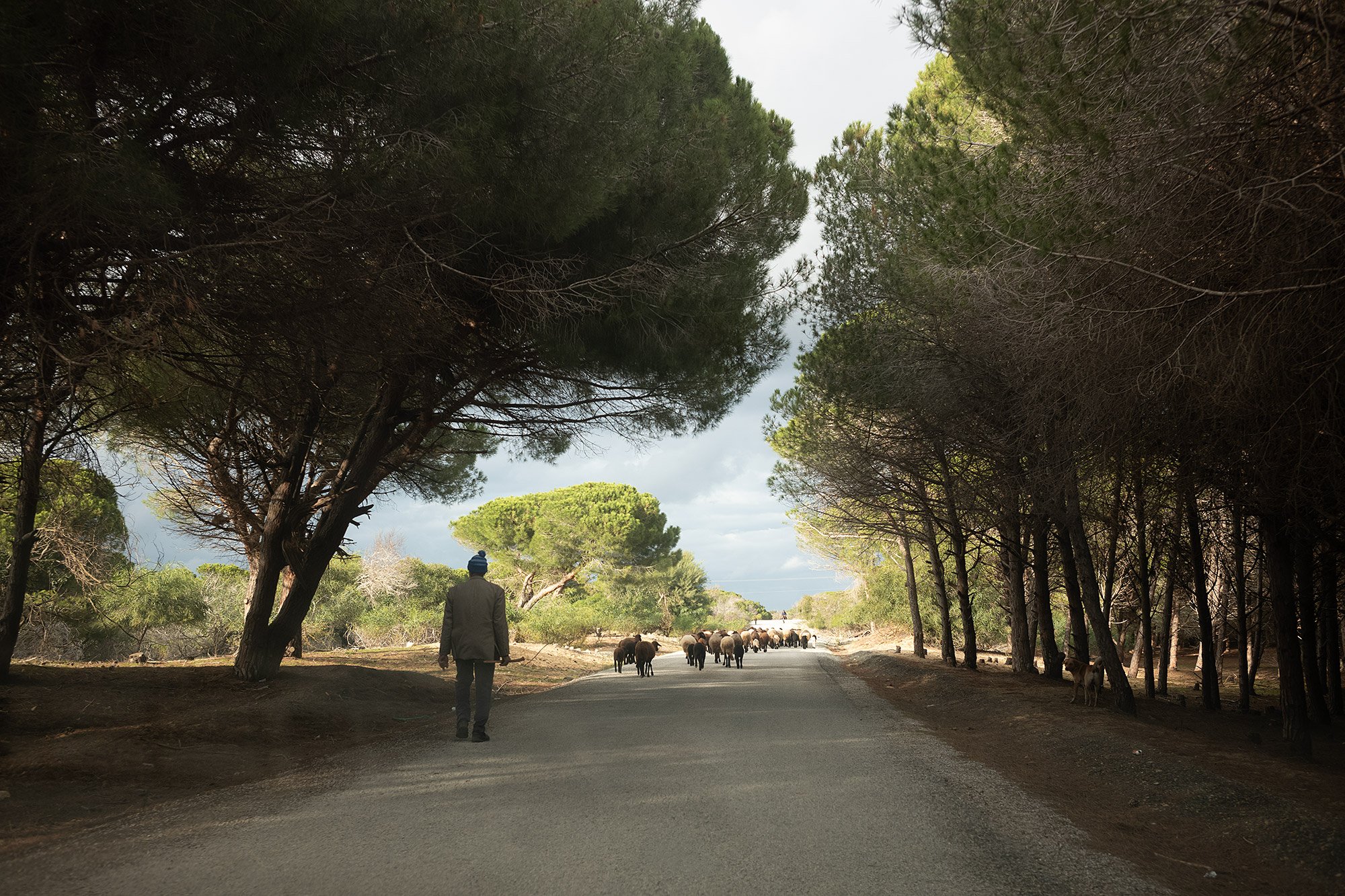
Norman stops to ask directions a number of times, confirming our route. The road is potholed, the final stretch dirt. We take a turn into a small village and Norman stops once more to ask directions. It’s the other way, down the dirt road.
Near the cape, he stops the car in a large makeshift lot. We’re one of only three.
I get out of the car and start walking towards Ras ben Sakka and a monument that stands upon the rocks; Norman follows.
It’s a beautiful spot, a rugged coastline made even more dramatic by the skies.

The monument commemorates the Cape Angela as the northernmost point of the african continent. At its base an arrow points south to the southernmost point: Cape Agulhas, South Africa, 8,060 km away.

Further on a sculpture of Africa rises from the earth. A plinth alongside it reads “Point le plus septentrional du continent Africain.” Etched into the base below the sculpture is its geographical position: 37° 20'53" N 9°44'44" E.
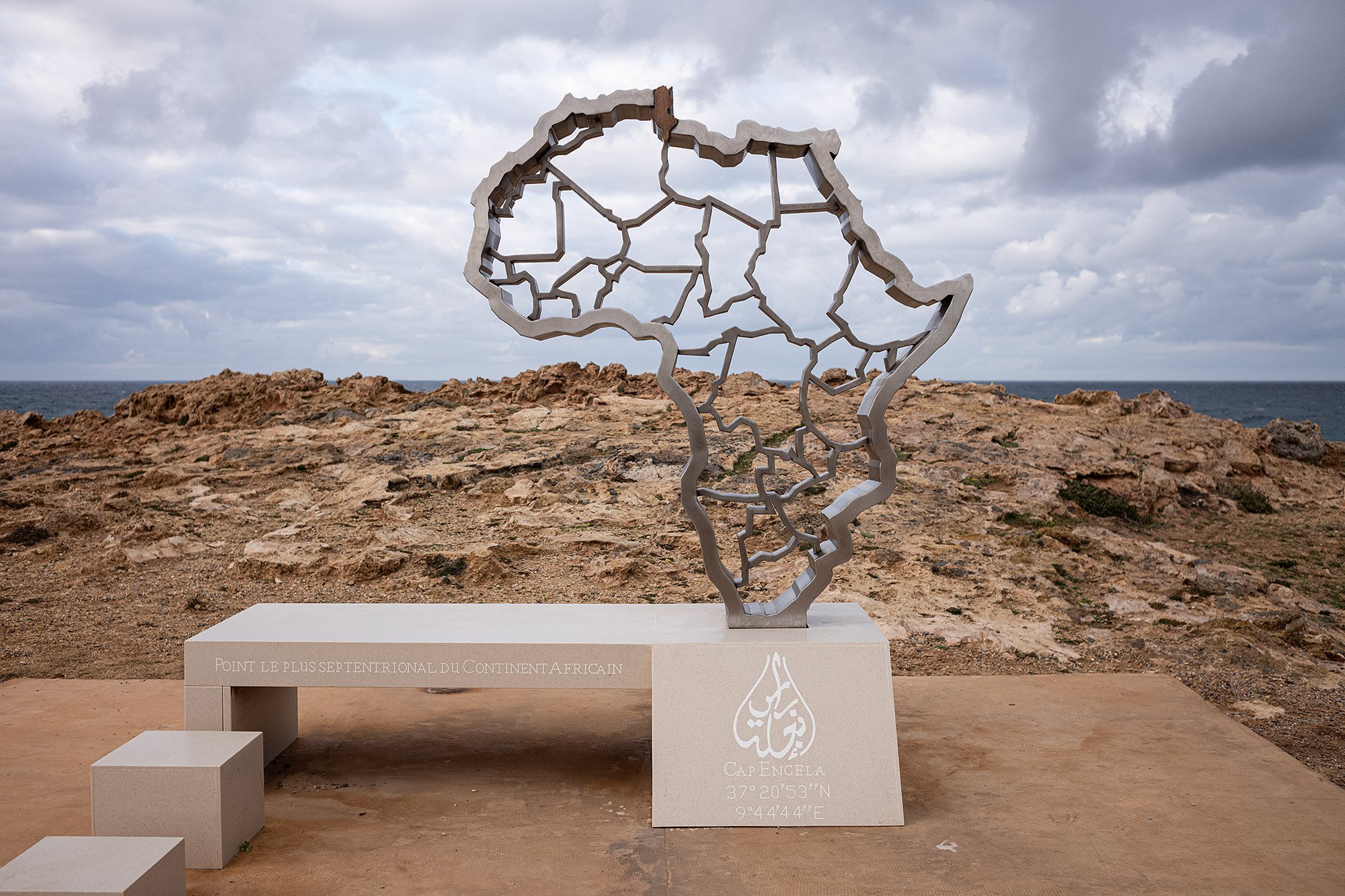
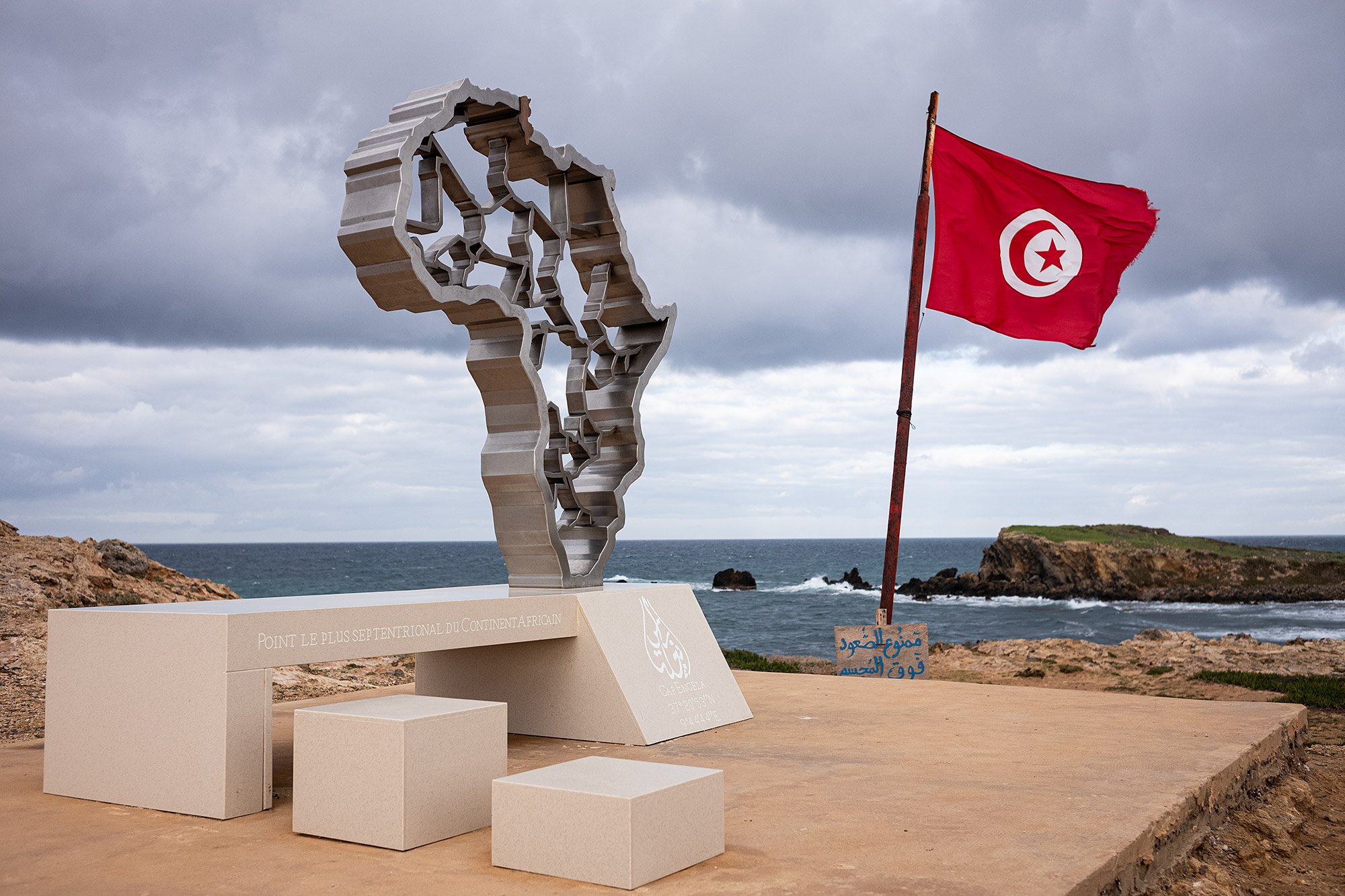


I’m thrilled to be here, standing atop Africa. I’m surprised at how affecting it is. I walk out past the sculpture of Africa to get closer to the edge of the continent and to stare out at the bluegreen sea towards Italy and Europe beyond the horizon. The wind whips at my coat.

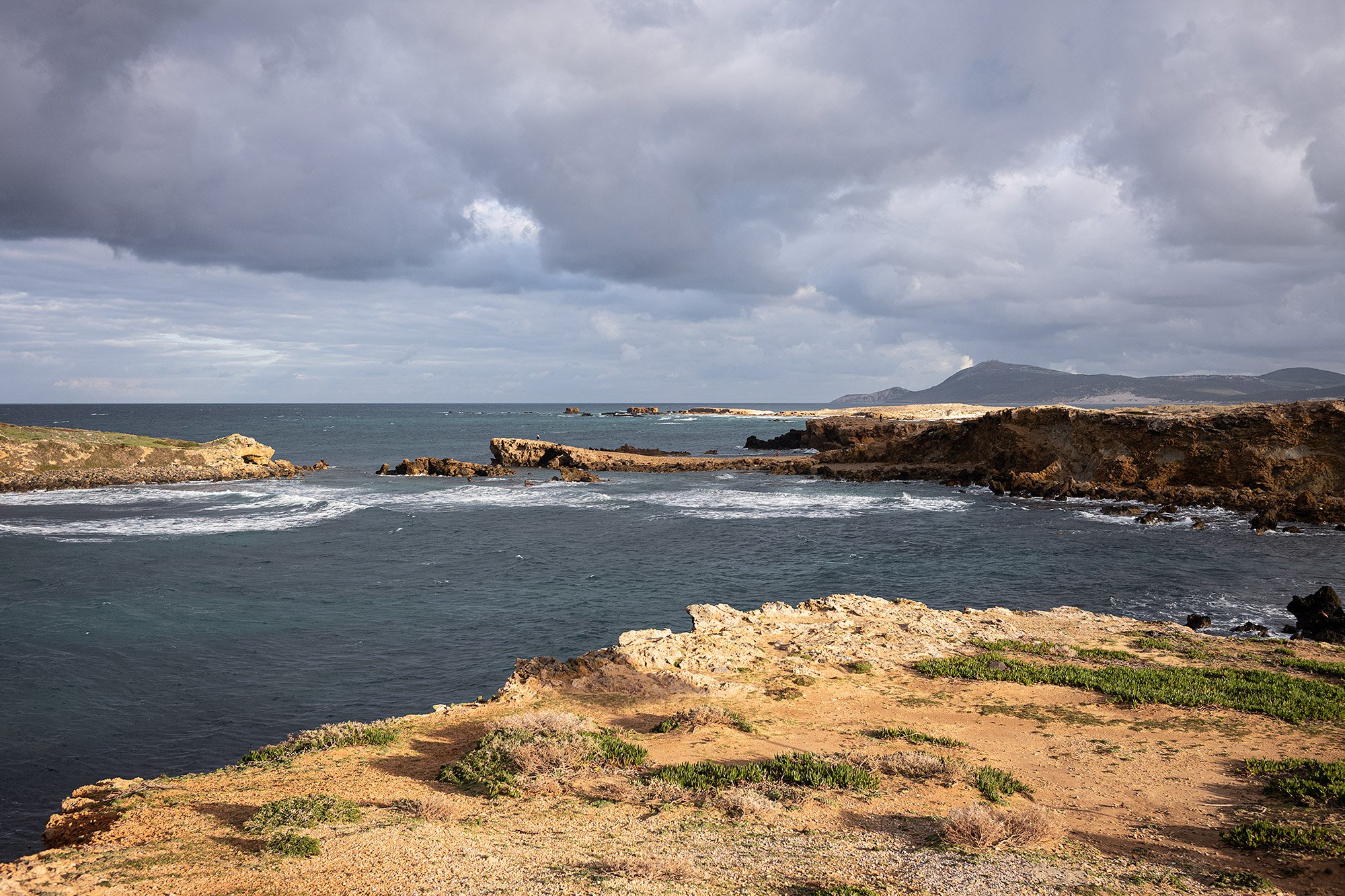
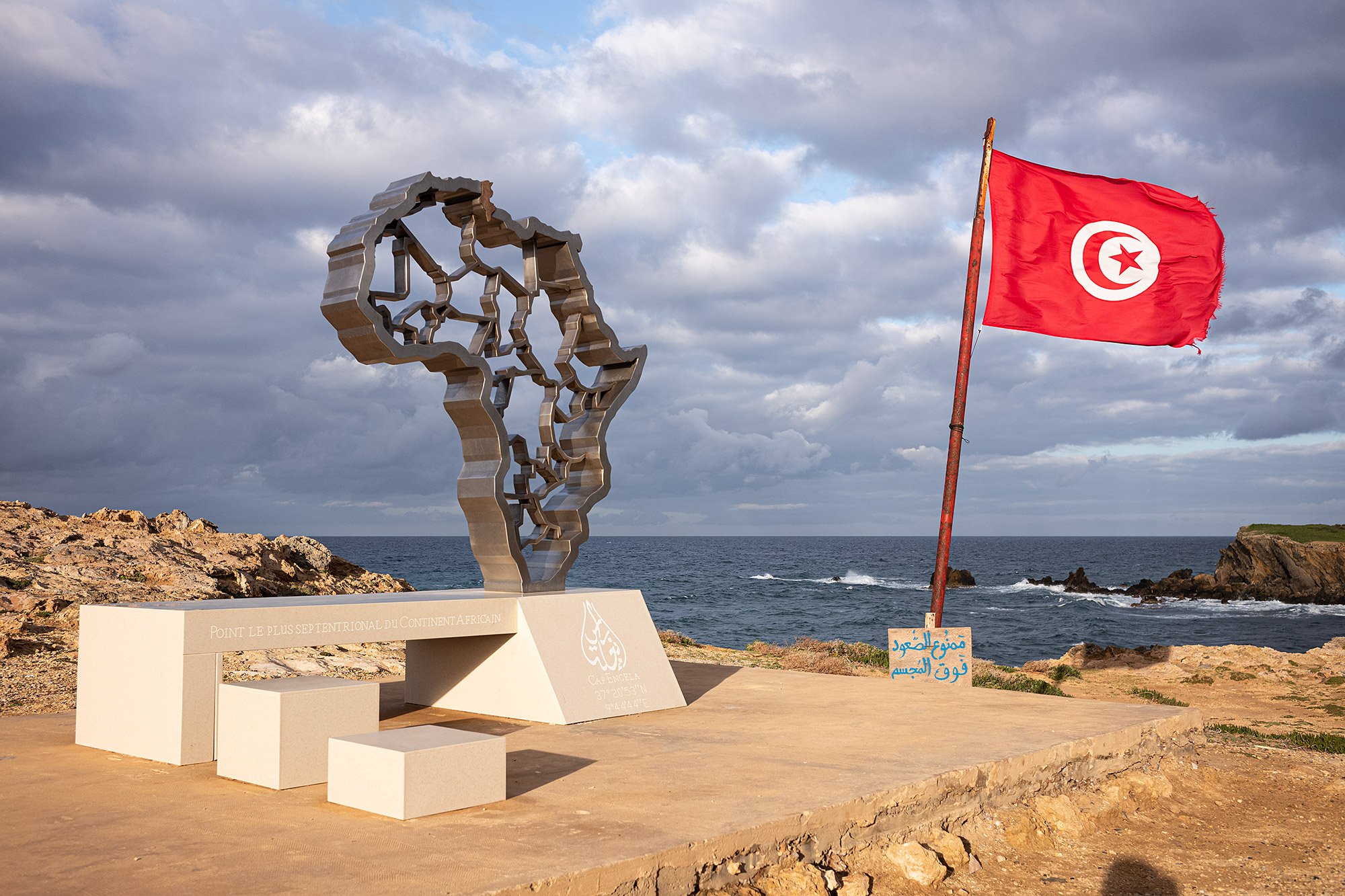
The skies change, the sun unveiled and then shrouded once again by cloud. We turn to walk back to the car and back towards the interior of the continent. From here all roads lead South.
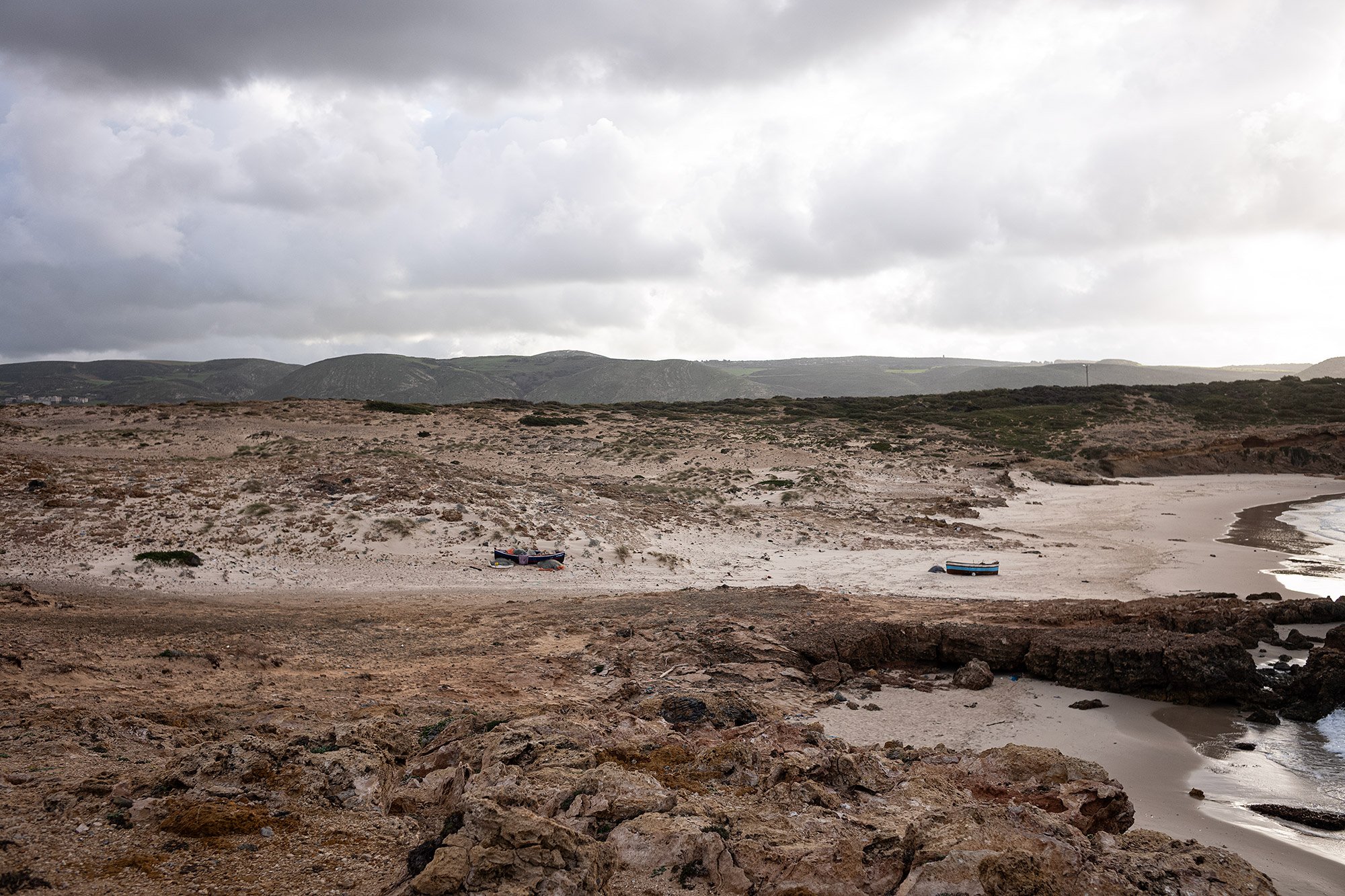


I walk to a beach filling a cove beside the lighthouse to look at the boats secured there before following Norman to the car. A family is exploring and I can see their small forms atop rocky cliffs rise above a rocky beach by the sea.
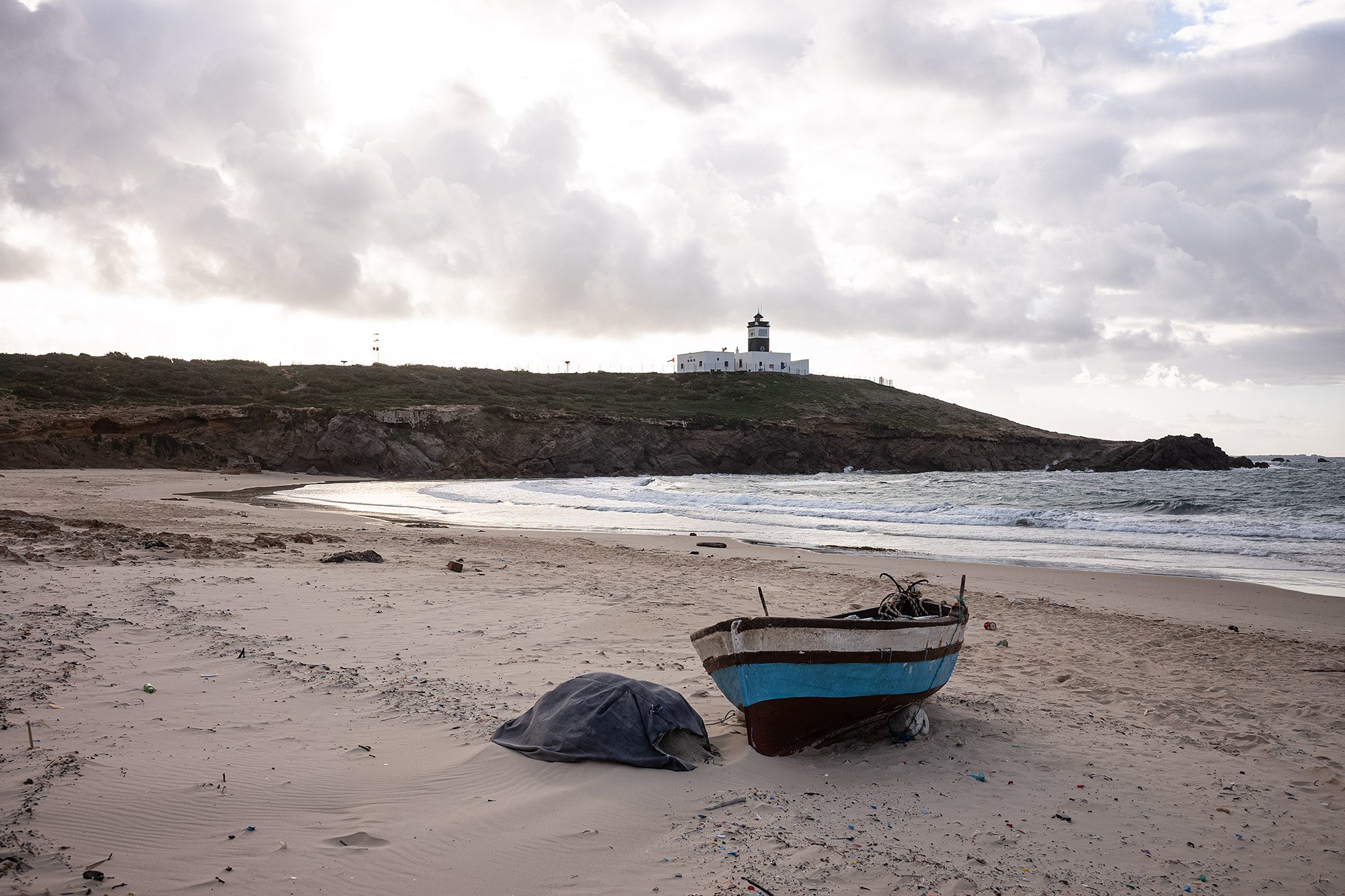


We follow the dirt road back to the main road, past fields and flocks of sheep. I roll my window down to bring myself closer to the surroundings.

Bright green fields and small towns pass by the windows. The rain holds off, and now and again the fields light up with the sun.
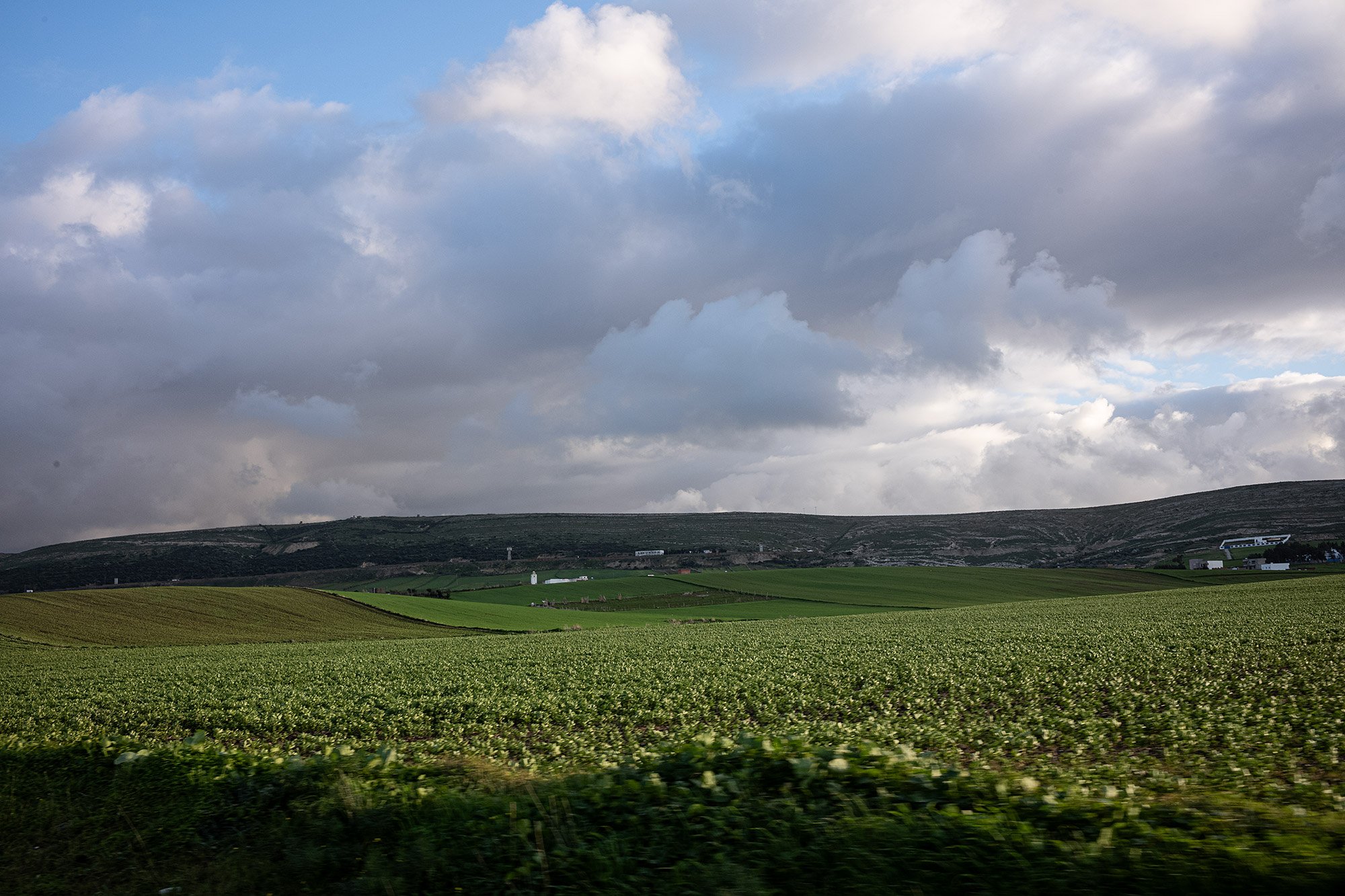

Back in Bizerte I ask Norman if he’d like to join me for a coffee. He thanks me but declines. He has to get back to his family.
I head back to the guesthouse to drop some things off and to edit some photos before dinner.
As I prepare to step out I meet Federico and Sara, a couple from Milan also staying at the guesthouse. We walk out together, splitting up once we leave the casbah.

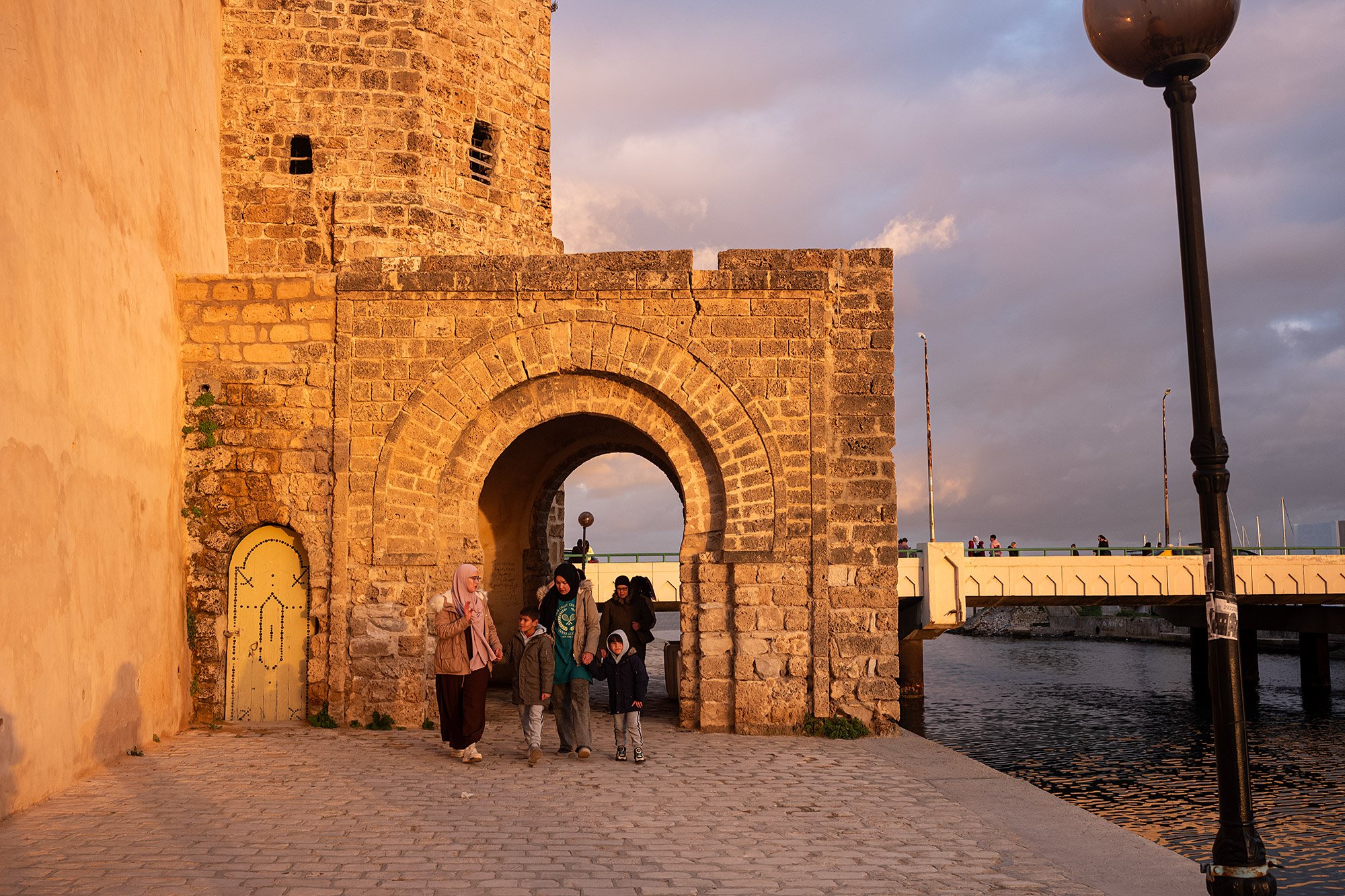


The sun has started to set and Bizerte is bathed its golden light. The sun continues its journey towards the horizon as I walk the port along the ramparts, and then back on the opposite side of the water to admire the play of light on the castle walls and the clouds.

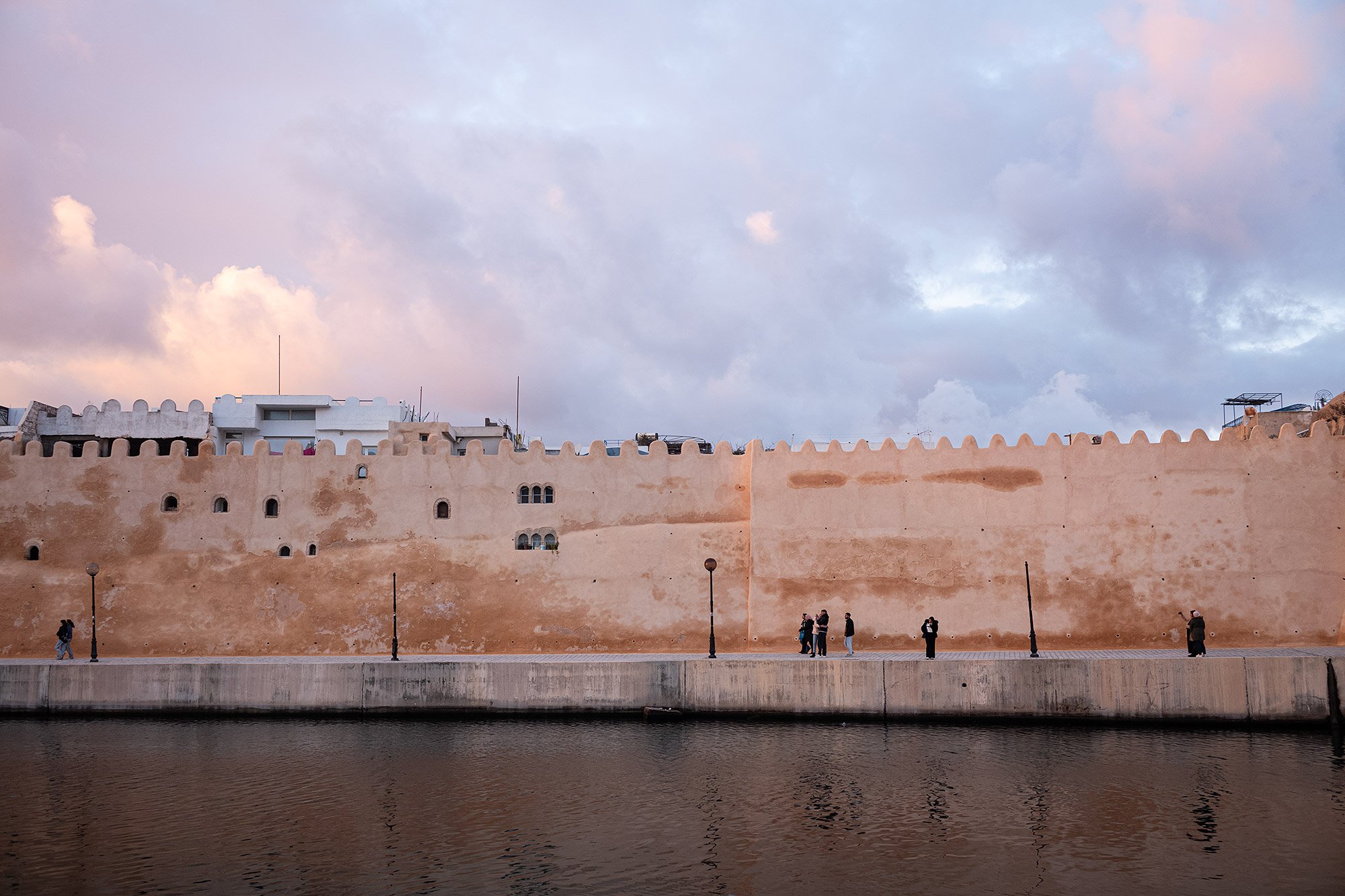

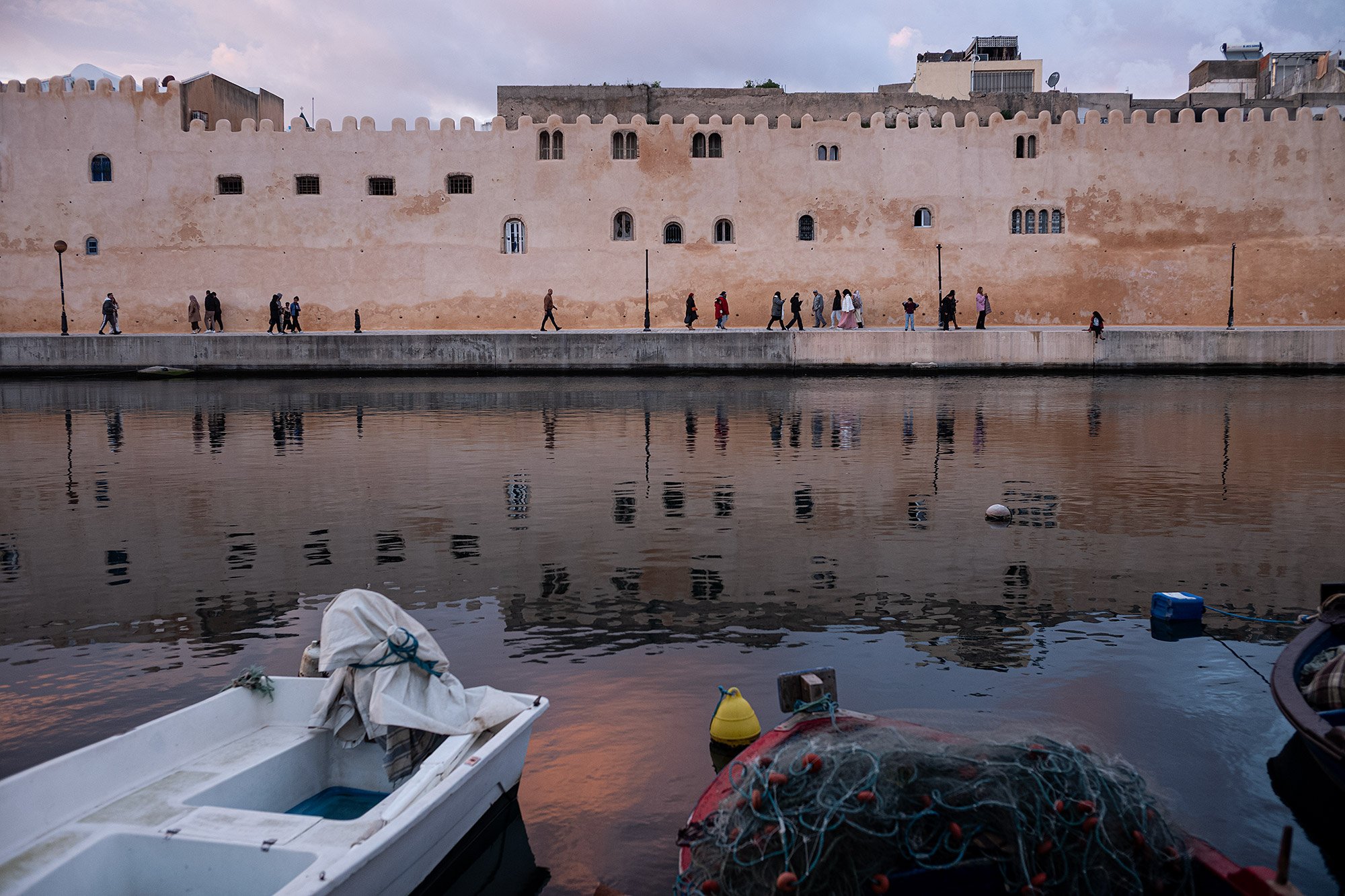
As dusk descends I reach the end of the port where fishermen relax by their nets collected on the cobblestoned pier. I ask if I can take their photo and they nod and pose before going back to their conversation.
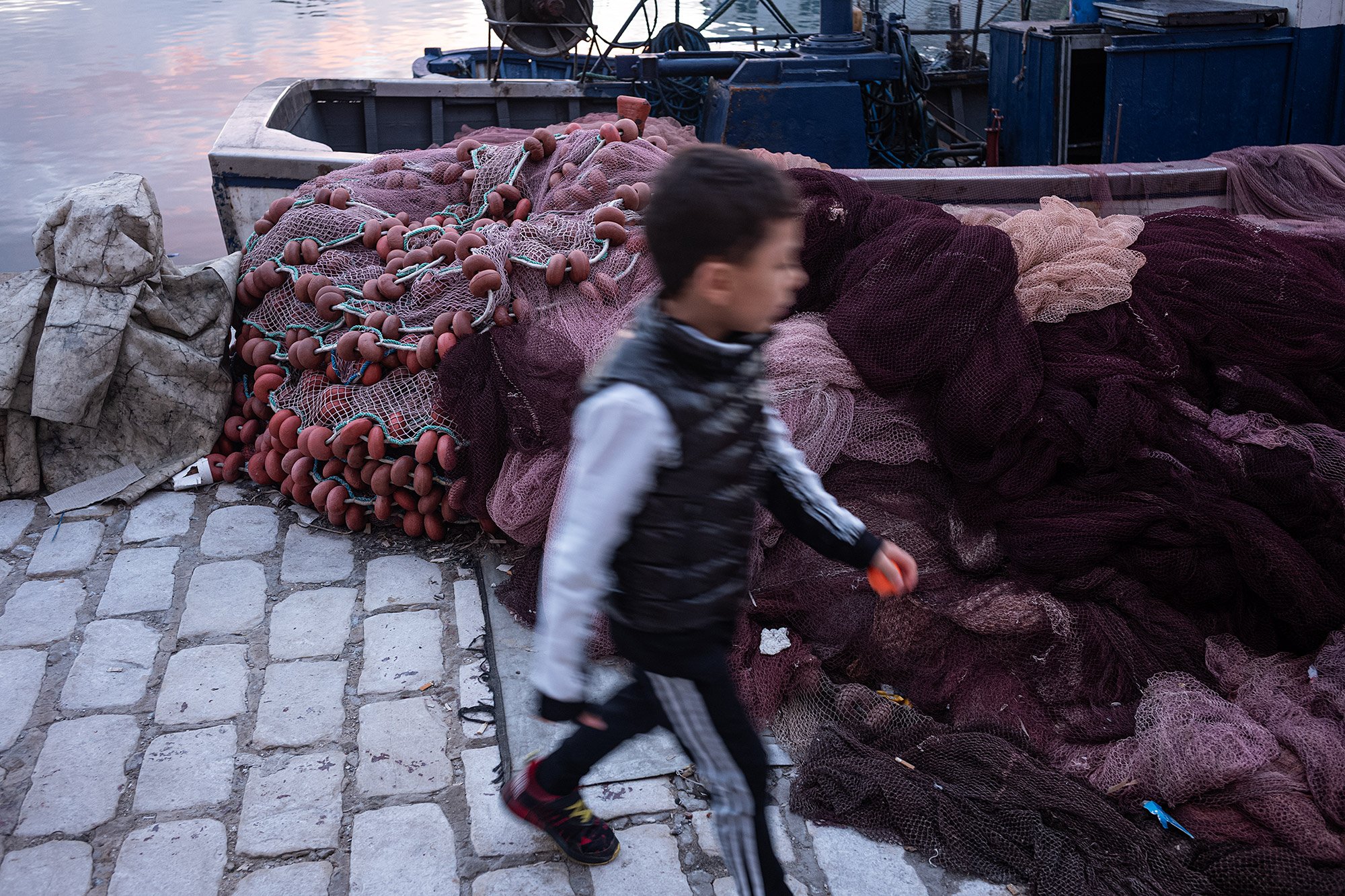

The buildings around the port take on a particularly beautiful hue in the dimming light. The water reflects the light back up at the clouds, a dull metallic blue broken by the colorful blocks that line its shore.
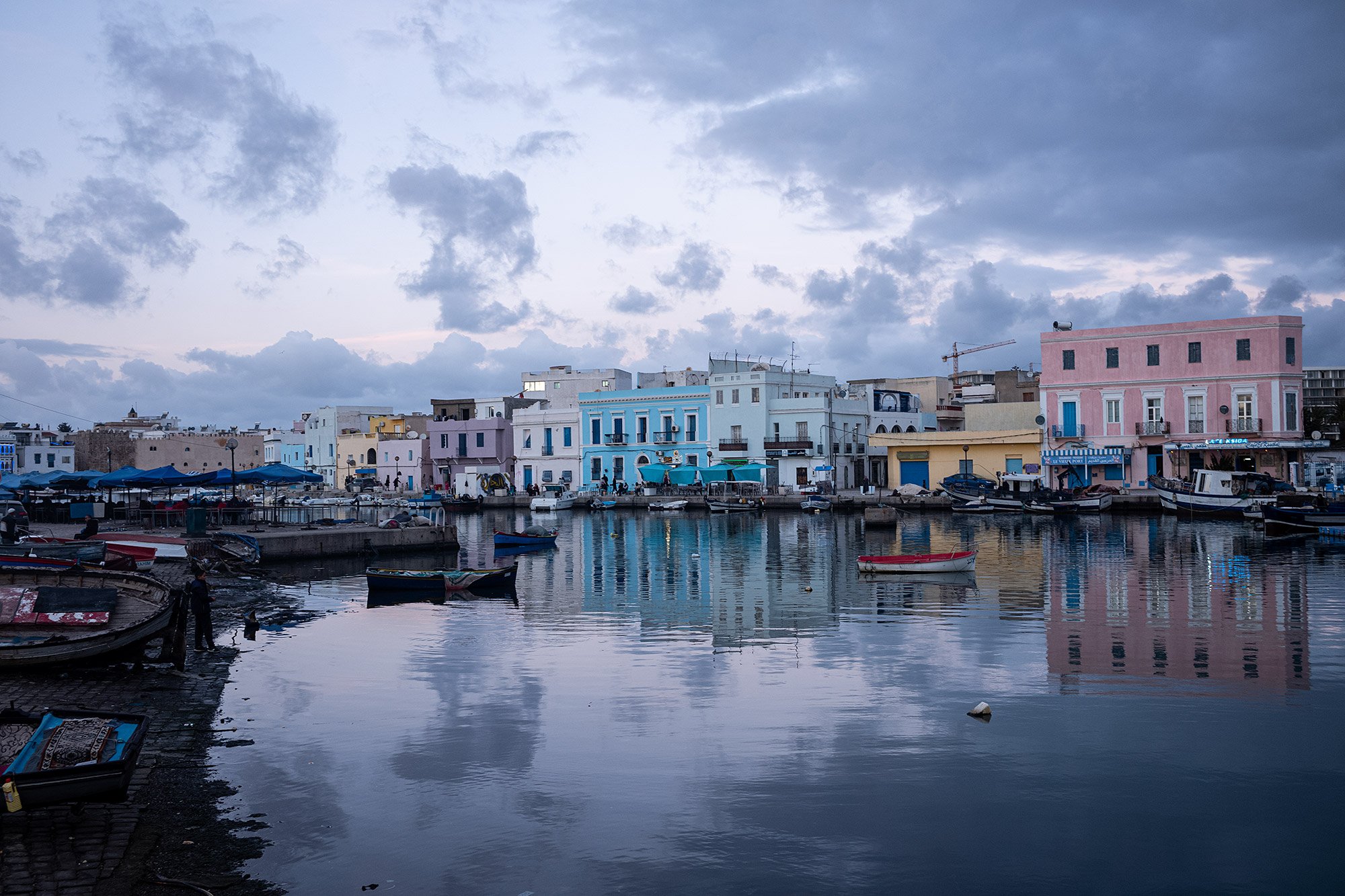
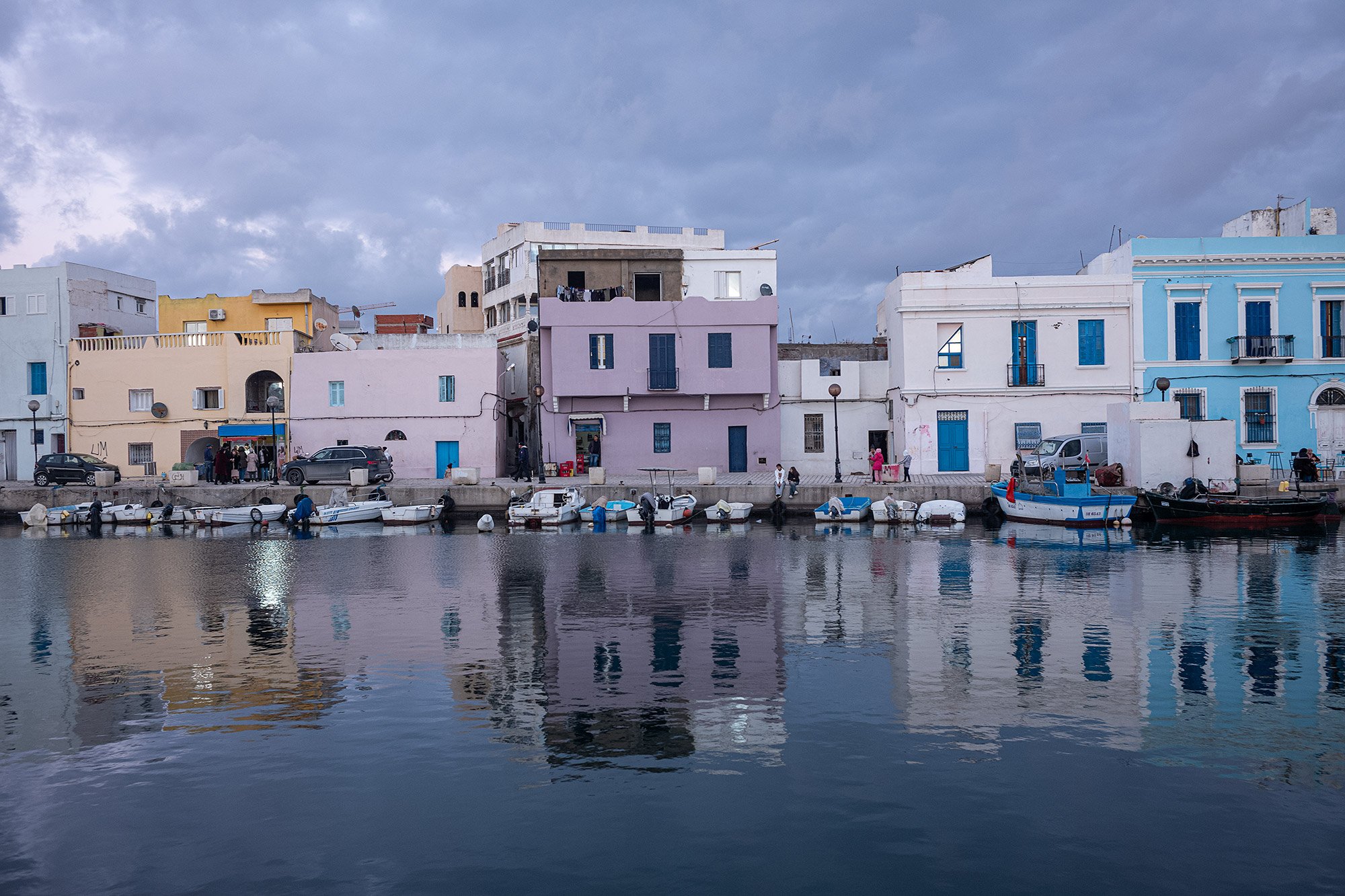
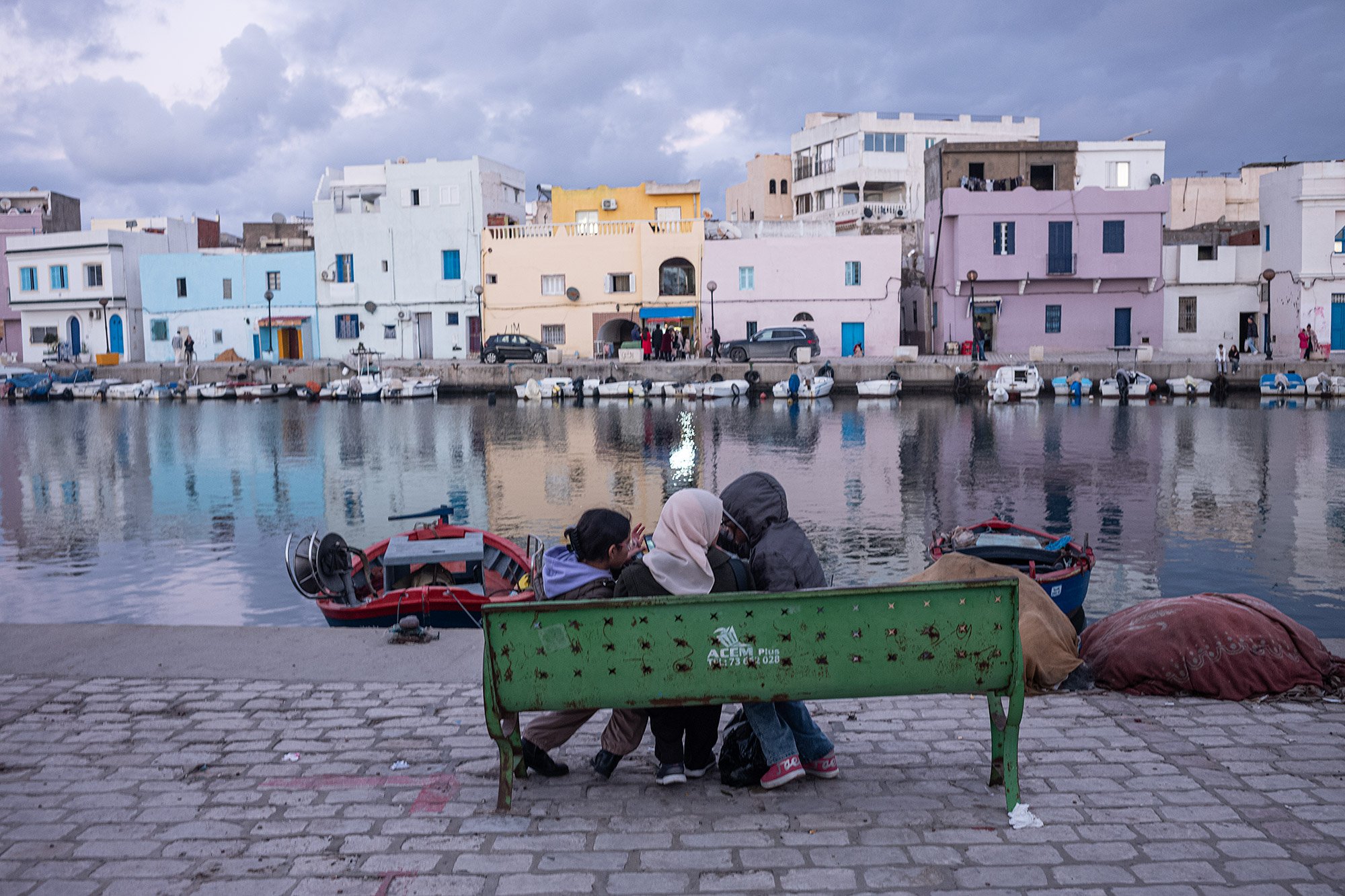
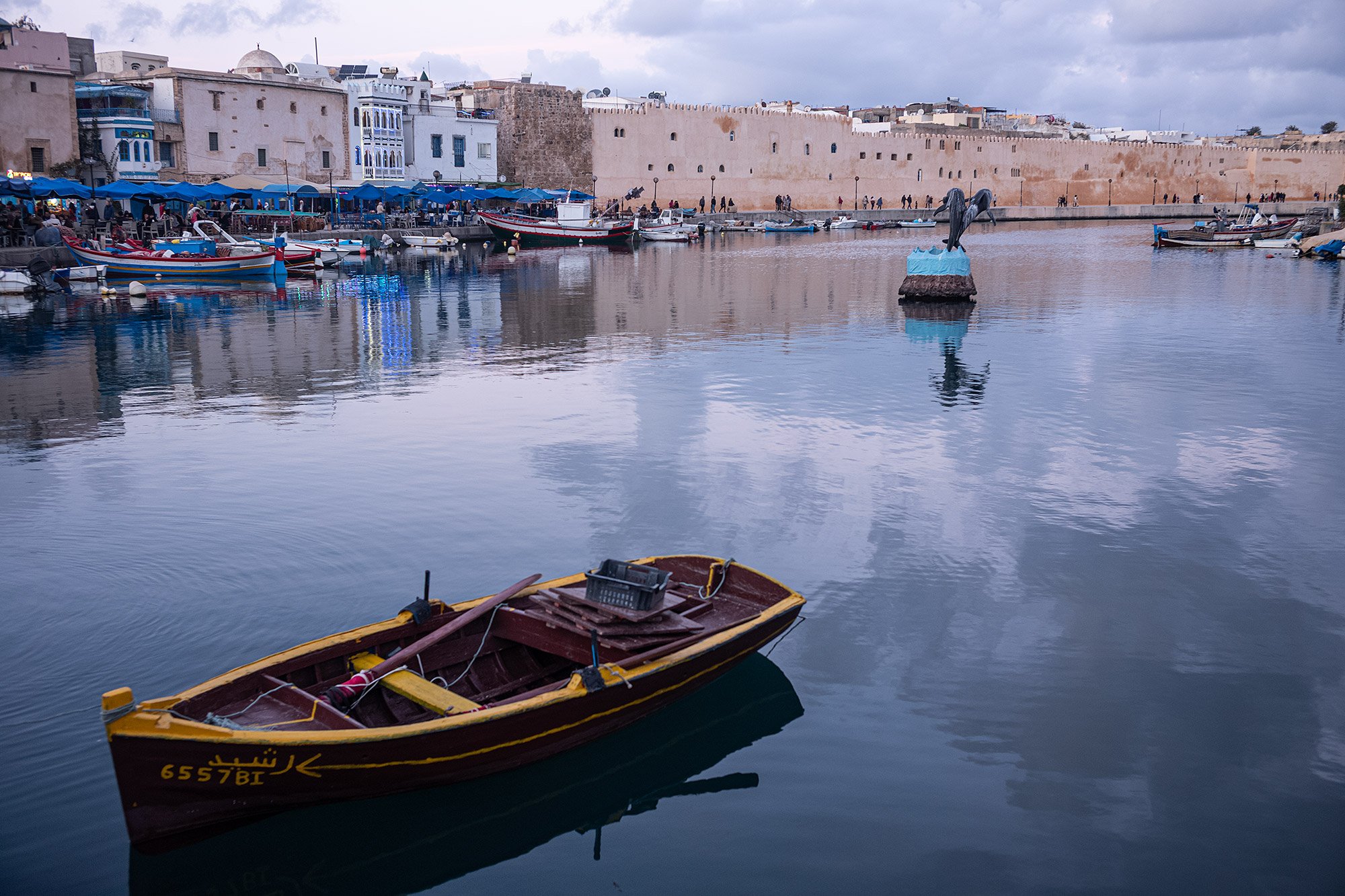
In the port’s northwestern plaza tables and carts have set up selling candy, snacks, and toys. Small crowds wander the area, buying things here and there, looking over restaurant menus as they decide where to eat.
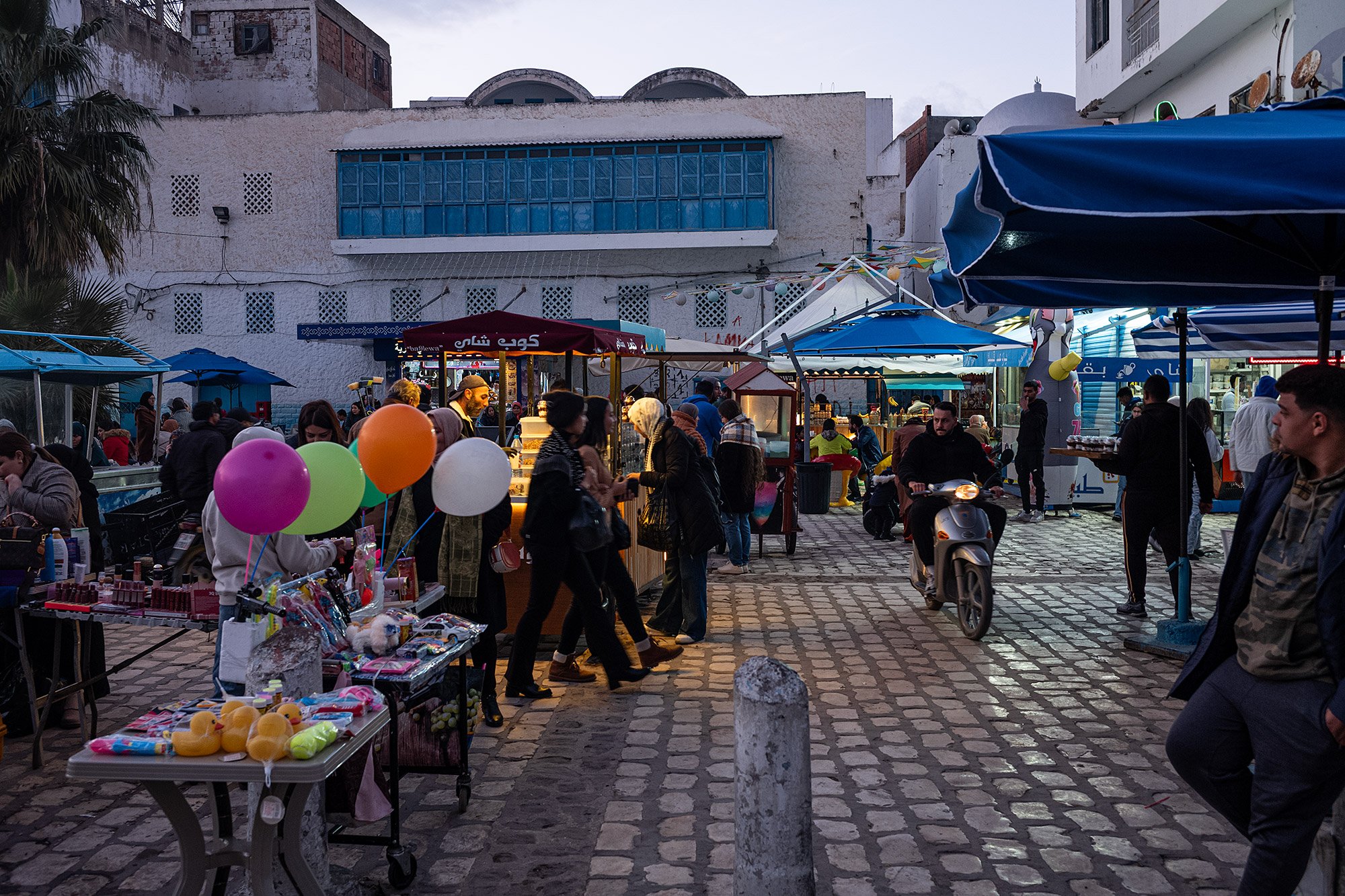
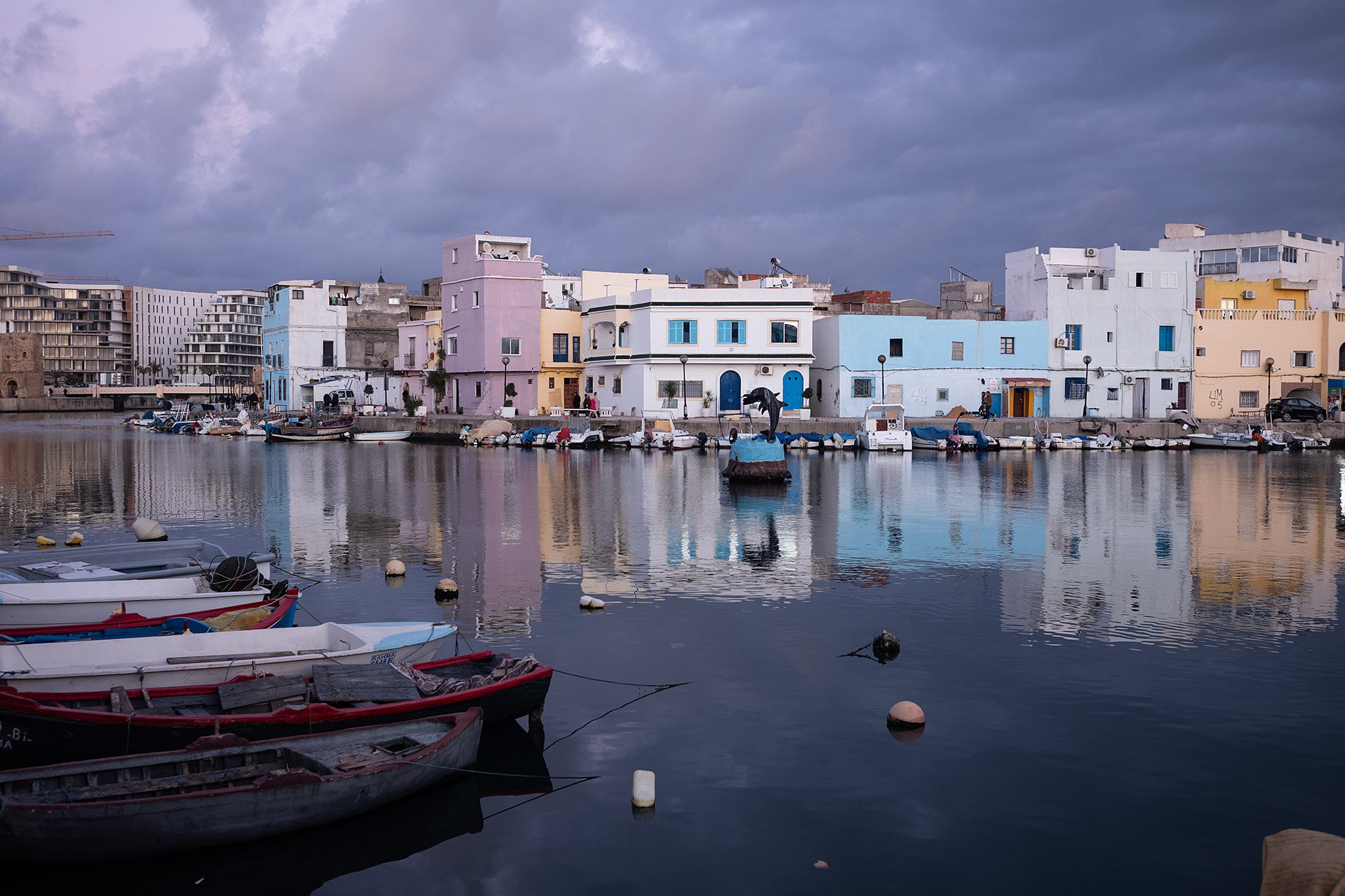
I check the menus myself and order a fish from one of the restaurants right by the plaza. I’m told to take a seat; my dinner will be brought to me. I sit by the water and watch the people milling about while I wait. Dinner is delicious.
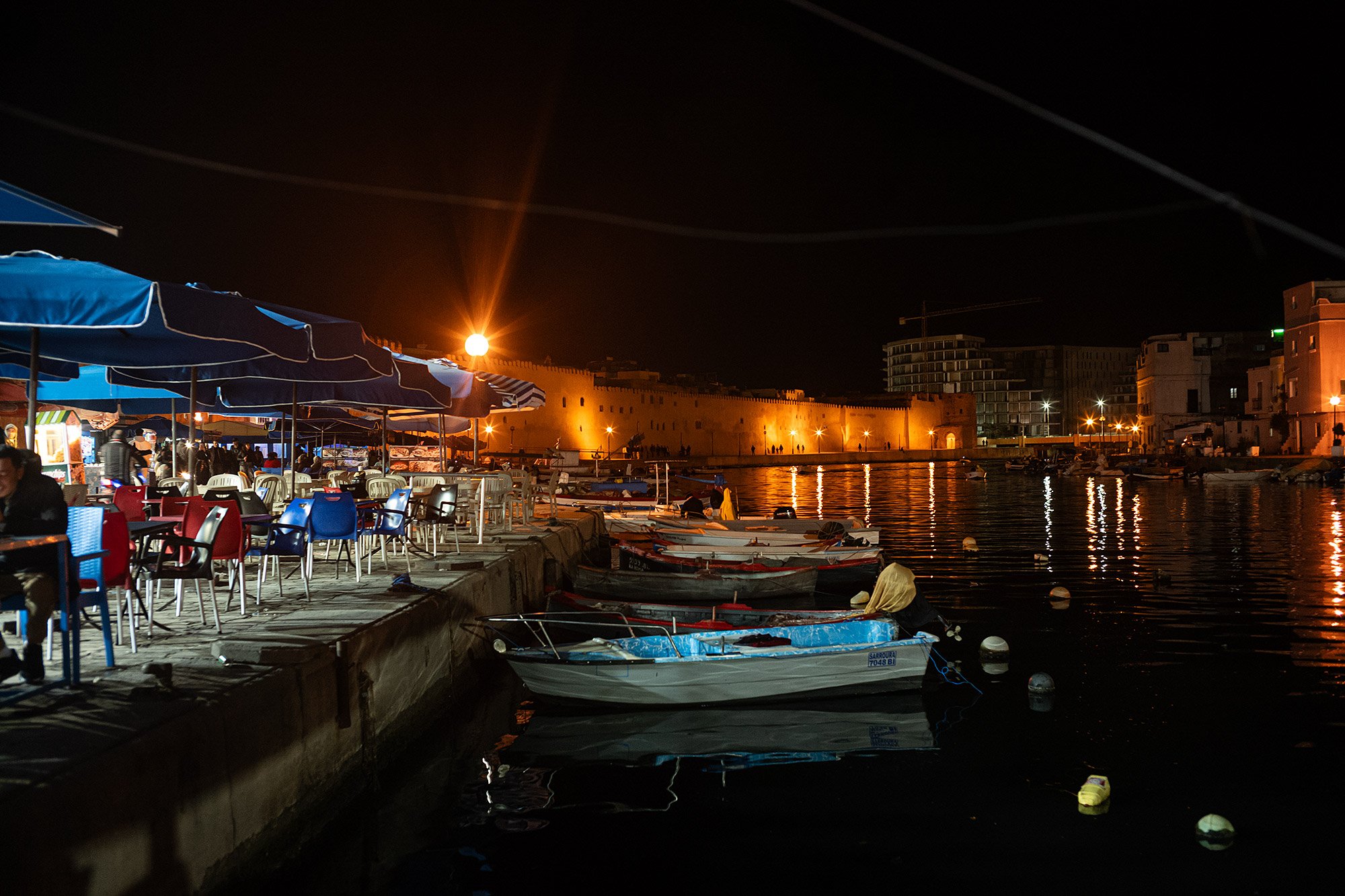
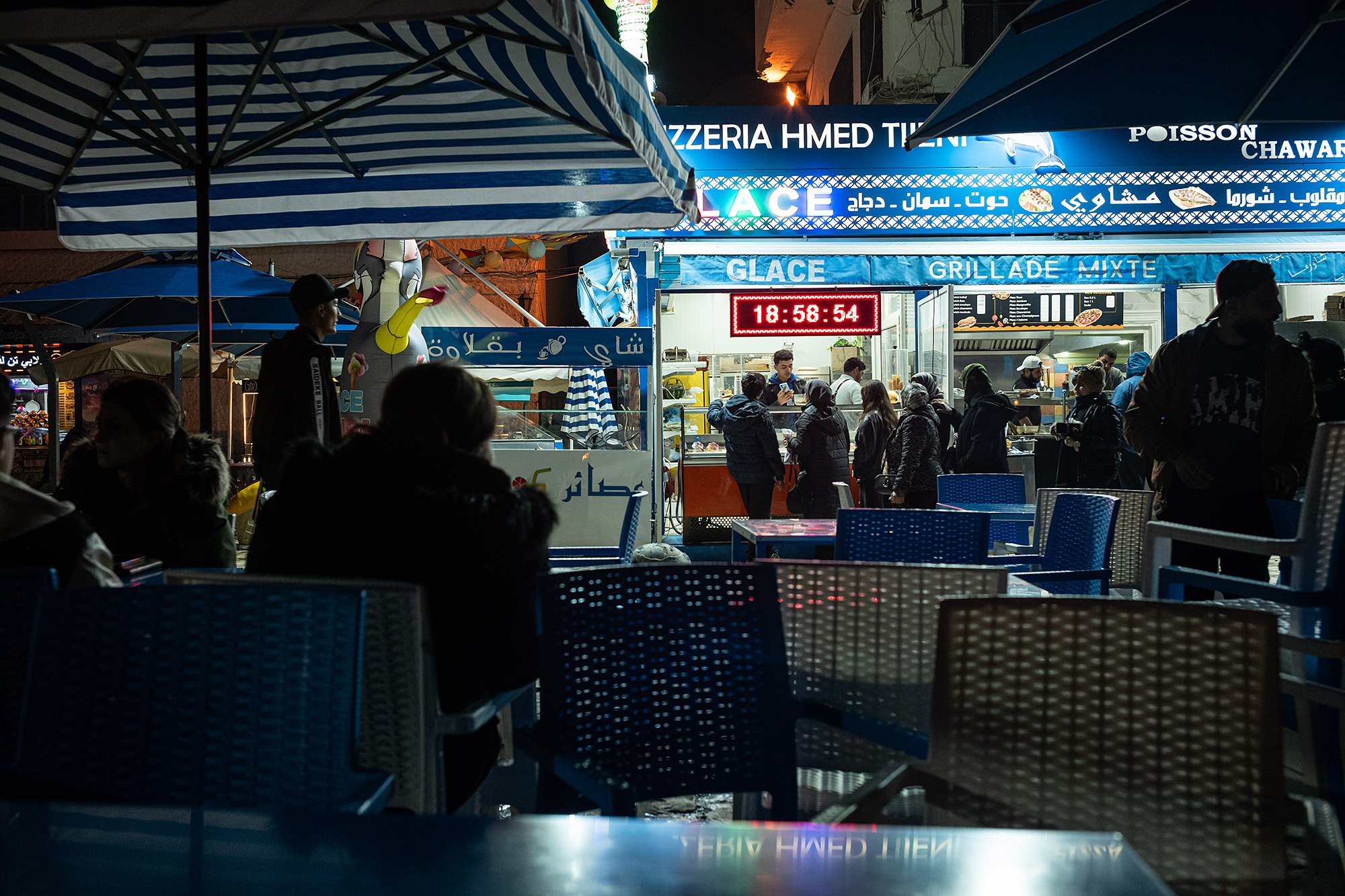
After dinner I find the Milanese couple in a small jewelry shop near the entrance to the castle, where every piece is made by Anna and her mother. I’m looking to see if there’s anything my niece might like.
A bracelet calls out, but to me. It’s made of onyx and hematite, and the jeweler tells me they have healing properties; onyx absorbs negative energy and helps with emotional strength, hematite is connected to balance, focus and grounding.
I’ve fallen in love with Bizerte and want something to remember it by. I purchase the bracelet and Anna resizes it to my wrist. She invites me to select a postcard from the wall as a keepsake.
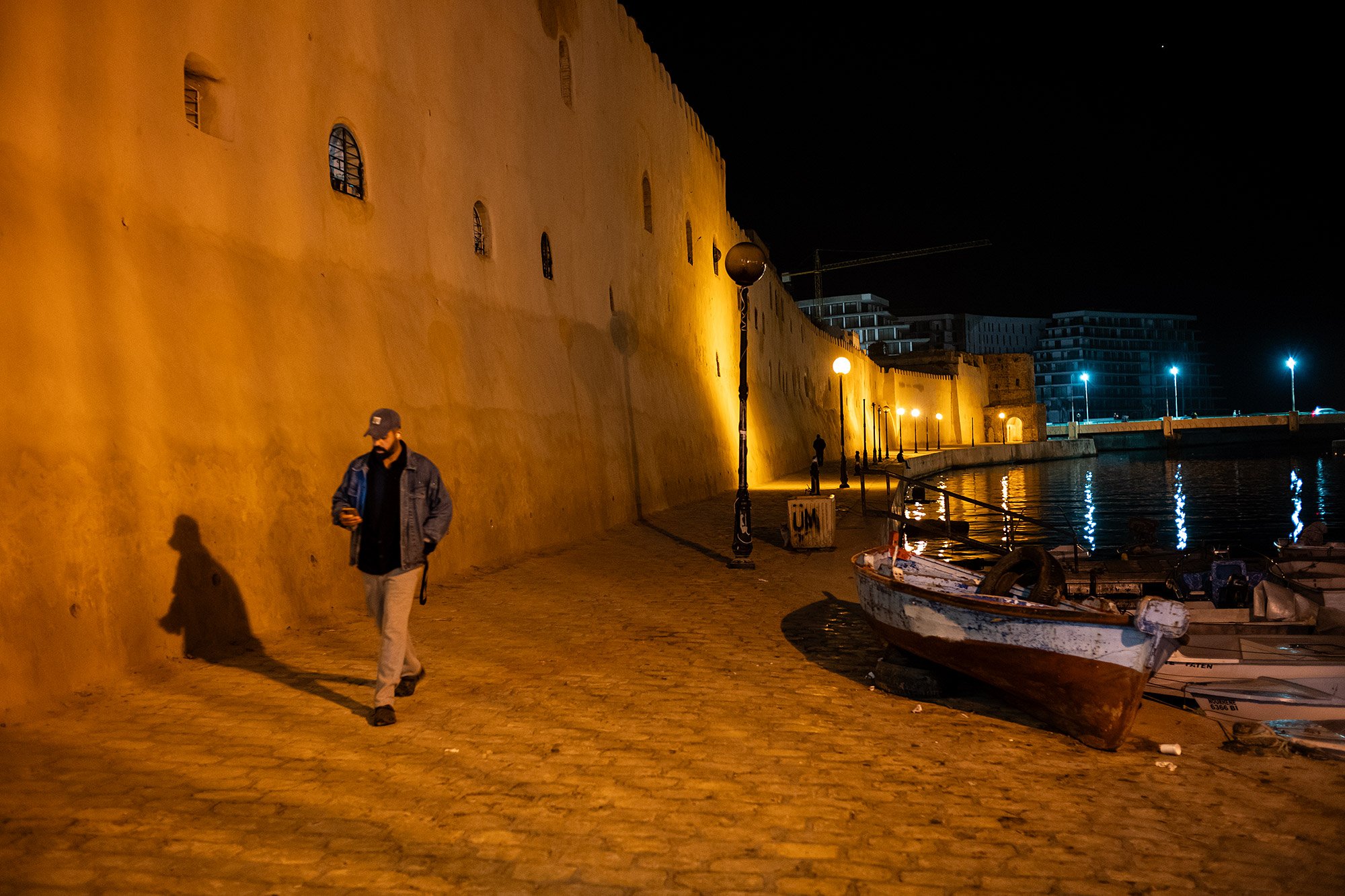


I’m not yet ready to go back to the guesthouse and decide to walk around the castle walls. Along the eastern walls I encounter a small amusement park. It’s lit up and ready for action, but there’s no one to amuse. Attendants sit in booths waiting for guests to arrive.




I walk back home along the northern ramparts of the castle. Here, it’s quiet, the hustle and bustle of the port left behind. It’s a lovely way to end the day, and I reflect upon the day before, the weeks before that. I’ve had a wonderful time in Tunisia, and this trip to Bizerte has been the perfect cap to the month.
Tomorrow I’ll be headed back to Tunis, and then to Dubai at the end of the week. Having just visited the northernmost point in Africa, I’ve committed mystlf to seeing the southernmost point; I’ve already started planning the trip in my mind. 🇹🇳
4 January 2025
